#Airlines Market Share
Explore tagged Tumblr posts
Text
Airlines Market May Set New Growth Story
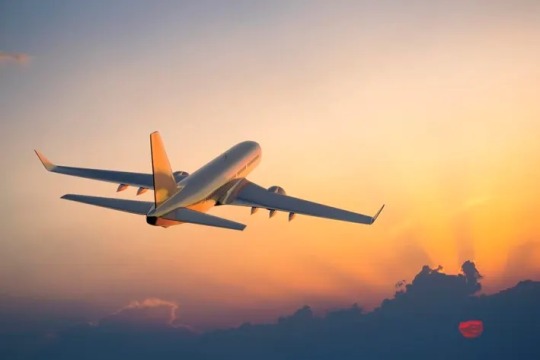
Global Airlines Market Report from AMA Research highlights deep analysis on market characteristics, sizing, estimates and growth by segmentation, regional breakdowns & country along with competitive landscape, player’s market shares, and strategies that are key in the market. The exploration provides a 360° view and insights, highlighting major outcomes of the industry. These insights help the business decision-makers to formulate better business plans and make informed decisions to improved profitability. In addition, the study helps venture or private players in understanding the companies in more detail to make better informed decisions. Some are the key & emerging players that are part of coverage and have being profiled are American Airlines Group (United States), Air France KLM (France), ANA Holdings (Japan), British Airways (United Kingdom), Delta Air Lines (United States), Deutsche Lufthansa (Germany), Hainan Airlines (China), Japan Airlines (Japan), LATAM Airlines Group (Chile), Qantas Airways (Australia). Get Free Exclusive PDF Sample Copy of This Research @ https://www.advancemarketanalytics.com/sample-report/63600-global-airlines-market Airlines are the companies which provides air transport services for traveling passengers and freight. These companies uses aircraft to supply these services and may form partnerships with other airlines for codeshare agreements. Airlines vary in size from small domestic airlines to full-service international airlines with double decker airlines.
The titled segments and sub-section of the market are illuminated below: by Services (Intercontinental, Domestic, Regional, International), End-User (Passenger, Freight)
Market Trends:
Demand for Eco-Friendly and Fuel Efficient Aircraft from Airline Companies
Opportunities:
Growing Tourism Industry Worldwide
Increasing Number of International Airports Worldwid
Market Drivers:
Increase in Number of Air Passengers Worldwide
Increased Disposable Income of the People in Emerging Countries
Advertisement of Tourist Places by Tourism Industries
Global Airlines market report highlights information regarding the current and future industry trends, growth patterns, as well as it offers business strategies to help the stakeholders in making sound decisions that may help to ensure the profit trajectory over the forecast years. Region Included are: North America, Europe, Asia Pacific, Oceania, South America, Middle East & AfricaCountry Level Break-Up: United States, Canada, Mexico, Brazil, Argentina, Colombia, Chile, South Africa, Nigeria, Tunisia, Morocco, Germany, United Kingdom (UK), the Netherlands, Spain, Italy, Belgium, Austria, Turkey, Russia, France, Poland, Israel, United Arab Emirates, Qatar, Saudi Arabia, China, Japan, Taiwan, South Korea, Singapore, India, Australia and New Zealand etc. Have Any Questions Regarding Global Airlines Market Report, Ask Our Experts@ https://www.advancemarketanalytics.com/enquiry-before-buy/63600-global-airlines-market Points Covered in Table of Content of Global Airlines Market:
Chapter 01 – Airlines Executive Summary
Chapter 02 – Market Overview
Chapter 03 – Key Success Factors
Chapter 04 – Global Airlines Market - Pricing Analysis
Chapter 05 – Global Airlines Market Background
Chapter 06 -- Global Airlines Market Segmentation
Chapter 07 – Key and Emerging Countries Analysis in Global Airlines Market
Chapter 08 – Global Airlines Market Structure Analysis
Chapter 09 – Global Airlines Market Competitive Analysis
Chapter 10 – Assumptions and Acronyms Chapter 11 – Research Methodology Read Detailed Index of full Research Study at @https://www.advancemarketanalytics.com/reports/63600-global-airlines-market Thanks for reading this article; you can also get individual chapter wise section or region wise report version like North America, Middle East, Africa, Europe or LATAM, Southeast Asia. Contact US : Craig Francis (PR & Marketing Manager) AMA Research & Media LLP Unit No. 429, Parsonage Road Edison, NJ New Jersey USA – 08837 Phone: +1 201 565 3262, +44 161 818 8166 [email protected]
#Global Airlines Market#Airlines Market Demand#Airlines Market Trends#Airlines Market Analysis#Airlines Market Growth#Airlines Market Share#Airlines Market Forecast#Airlines Market Challenges
0 notes
Text
Indian Airlines Market Share in International Passenger Traffic to Reach 50% by FY28
Indian Airlines plans to reach 50% of the international passenger traffic market by FY28. As per a report by CRISIL Ratings, Indian airlines are likely to see their share in international passenger traffic increase by 700 basis points, reaching around 50% by FY28. The significant increase from 43% in the previous fiscal year marks a new development for the Indian aviation market.
Indian Airlines market share growth is driven not only by increased aircraft numbers but also by effective route expansion.
0 notes
Text
All bets are off

When unions are outlawed, only outlaws will have unions. Unions don't owe their existence to labor laws that protect organizing activities. Rather, labor laws exist because once-illegal unions were formed in the teeth of violent suppression, and those unions demanded – and got – labor law.
Bosses have hated unions since the start, and they've really hated laws protecting workers. Dress this up in whatever self-serving rationale you want – "the freedom to contract," or "meritocracy" – it all cashes out to this: when workers bargain collectively, value that would otherwise go to investors and executives goes to the workers.
I'm not just talking about wages here, either. If an employer is forced – by a union, or by a labor law that only exists because of union militancy – to operate a safe workplace, they have to spend money on things like fire suppression, PPE, and paid breaks to avoid repetitive strain injuries. In the absence of some force that corrals bosses into providing these safety measures, they can use that money to pay themselves, and externalize the cost of on-the-job injuries to their workers.
The cost and price of a good or service is the tangible expression of power. It is a matter of politics, not economics. If consumer protection agencies demand that companies provide safe, well-manufactured goods, if there are prohibitions on price-fixing and profiteering, then value shifts from the corporation to its customers.
Now, if labor has few rights and consumers have many rights, then bosses can pass their consumer-side losses on to their workers. This is the Walmart story, the Amazon story: cheap goods paid for with low wages and dangerous working conditions. Likewise, if consumer rights are weak but labor rights are strong, then bosses can pass their costs onto their customers, continuing to take high profits by charging more. This is the story of local gig-work ordinances like NYC's, which guaranteed a minimum wage to delivery drivers – restaurateurs responded by demanding the right to add a surcharge to their bills:
https://table.skift.com/2018/06/22/nyc-surcharge-debate/
But if labor and consumer groups act in solidarity, then they can operate as a bloc and bosses and investors have to eat shit. Back in 2017, the pilots' union for American Airlines forced their bosses into a raise. Wall Street freaked out and tanked AA's stock. Analysts for big banks were outraged. Citi's Kevin Crissey summed up the situation perfectly, in a fuming memo: "This is frustrating. Labor is being paid first again. Shareholders get leftovers":
https://www.vox.com/new-money/2017/4/29/15471634/american-airlines-raise
Limiting the wealth of the investor class also limits their power, because money translates pretty directly into political power. This sets up a virtuous cycle: the less money the investor class has to spend on political projects, the more space there is for consumer- and labor-protection laws to be enacted and enforced. As labor and consumer law gets more stringent, the share of the national income going to people who make things, and people who use the things they make, goes up – and the share going to people who own things goes down.
Seen this way, it's obvious that prices and wages are a political matter, not an "economic" one. Orthodox economists maintain the pretense that they practice a kind of physics of money, discovering the "natural," "empirical" way that prices and wages move. They dress this up with mumbo-jumbo like the "efficient market hypothesis," "price discovery," "public choice," and that old favorite, "trickle-down theory." Strip away the doublespeak and it boils down to this: "Actually, your boss is right. He does deserve more of the value than you do":
https://pluralistic.net/2024/09/09/low-wage-100/#executive-excess
Even if you've been suckered by the lie that bosses have a legal "fiduciary duty" to maximize shareholder returns (this is a myth, by the way – no such law exists), it doesn't follow that customers or workers share that fiduciary duty. As a customer, you are not legally obliged to arrange your affairs to maximize the dividends paid by to investors in your corporate landlord or by the merchants you patronize. As a worker, you are under no legal obligation to consider shareholders' interests when you bargain for wages, benefits and working conditions.
The "fiduciary duty" lie is another instance of politics masquerading as economics: even if bosses bargain for as big a slice of the pie as they can get, the size of that slice is determined by the relative power of bosses, customers and workers.
This is why bosses hate unions. It's why the scab presidency of Donald Trump has waged all-out war on unions. Trump just effectively shuttered the National Labor Relations Board, unilaterally halting its enforcement actions and investigations. He also illegally fired one of the Democratic NLRB board members, leaving the agency with too few board members to take any new actions, meaning that no unions can be recognized – indeed, the NLRB can't do anything – for the foreseeable future:
https://www.npr.org/2025/01/28/nx-s1-5277103/nlrb-trump-wilcox-abruzzo-democrats-labor
Trump also fired the NLRB's outstanding General Counsel, Jennifer Abruzzo, who was one of the stars of the Biden administration, who promulgated rules that decisively tilted the balance in favor of labor:
https://pluralistic.net/2023/09/06/goons-ginks-and-company-finks/#if-blood-be-the-price-of-your-cursed-wealth
Trump is playing Grinch here – he's descended upon Whoville to take all the Christmas decorations, in the belief that these are the source of Christmas. But the Grinch was wrong (and so is Trump): Christmas was in the heart of the Whos, and the tinsel and baubles were the expression of that Christmas spirit. Likewise, labor rights come from labor organizing, not the other way around.
Labor rights were enshrined in federal law in 1935, with the National Labor Relations Act. Bosses hated – and hate – the NLRA. 12 years later, they passed the Taft-Hartley Act, which substantially gutted the NLRA. Most notably, Taft-Hartley bans "sympathy strikes" – when unions walk out in support of one another. Sympathy strikes are a hugely powerful way for workers to claim value away from bosses and investors, which is why bosses got rid of them.
But even then, bosses who were honest with themselves would admit that they preferred life under the NLRA to life before it. Remember: labor militancy created the NLRA, not the other way around. When workers didn't have the legal means to organize, they organized by illegal means. When they didn't have legal ways of striking, they struck illegally. The result was pitched battles, even bloodbaths, as cops beat and even killed labor organizers. Bosses hired thugs who committed mass murder – literally. In 1913, strikebreakers working for the Calumet and Hecla Mining Company started a stampede during a union Christmas party that killed 73 people, including many copper miners' children:
https://en.wikipedia.org/wiki/Italian_Hall_disaster
Workers didn't take this lying down. Violence was met with violence. Bombs went off outside factories and stately mansions. There was gunfire and arson. Bosses had to hire armed guards to escort them as they scurried between their estates and their fancy parties and their executive offices. The country was in a state of near-perpetual chaos.
The NLRA created a set of rules for labor/boss negotiations – rules that helped workers claim a bigger slice of the pie without blood in the streets. But the NLRA also had benefits for bosses: unions were obliged to play by its rules, if they wanted to reap its benefits. The NLRA didn't just put a ceiling over boss power – it also put a ceiling over worker militancy. Von Clausewitz says that "war is politics by other means," which implies that politics are war by other means. The alternative to politics isn't capitulation, it's war.
Trump has torn up the rules to the labor game, but that doesn't mean the game ends. That just means there are no rules.
The labor movement has many great organizer/writers, but few can match the incredible Jane McAlevey, who died of cancer last summer (rest in power). In her classic A Collective Bargain, McAlevey describes her organizer training, from a tradition that went back to the days before the National Labor Relations Act:
https://pluralistic.net/2023/04/23/a-collective-bargain/
McAlevey was very clear that labor law owes its existence to union power, not the other way around. She explains very clearly that union organizers invented labor law after they invented unions, and that unions can (and indeed, must) exist separately from government agencies that are charged with protecting labor law. But she goes farther: in Collective Bargain, McAlevey describes how the 2019 LA Teachers' Strike didn't just win all the wage and benefits demands of the teachers, but also got the school district to promise to put a park or playground near every school in the system, and got a ban on ICE agents harassing parents at the school gates.
This wildly successful strike forged bonds among teachers, and between teachers and their communities. These teachers went on to run a political get-out-the-vote campaign in the 2020 elections and elected two Democratic reps to Congress and secured the Dems' majority. McAlevey contrasted the active way good unions involve workers as participants with the thin, anemic way that the Democratic Party engages with supporters – solely by asking them for money in a stream of frothing, clickbait text messages. As McAlevey wrote, "Workplace democracy is a training ground for true national democracy."
Militant labor doesn't just protect labor rights – it protects human rights. Remember: MLK, Jr was assassinated while campaigning for union janitors in Memphis. LA teachers ended ICE sweeps at the school gates. Librarian unions are leading the fight against book bans.
The good news is that public opinion has swung wildly in favor of unions over the past decade. More people want to join unions than at any time in generations. More people support unions that at any time in generations.
The bad news is that union leadership fucking suuuuuuuucks. As Hamilton Nolan writes, union bosses are sitting on vast, heretofore unseen warchests of cash, and they just experienced a four-year period of governmental support for unions unheard of since the Carter administration, and they did fuck all with that opportunity:
https://www.hamiltonnolan.com/p/confirmed-unions-squandered-the-biden
Big unions have effectively stopped trying to organize new workers, even when workers beg them for help forming a union. Union organizing budgets are so small as to be indistinguishable from zero. Despite the record number of workers who want to be in a union, the number of workers who are in a union actually fell during the Biden years.
Indeed, some union bosses actually campaigned for Trump, a notorious scab. Teamsters boss Sean O'Brien spoke at the fucking RNC, a political favor that Trump repaid by killing the NLRB and every labor enforcement action and investigation in the country. Nice one, O'Brien. See you in hell:
https://www.theatlantic.com/politics/archive/2024/08/teamster-union-trump/679513/
Union bosses squandered a historical opportunity to build countervailing power. Now, Trump's stormtroopers are rounding up workers with the goal of illegally deporting them. Fascism is on the rise. Labor and fascism are archenemies. Organized labor has always been the biggest threat to fascism, every time it has reared its head. That's why fascists target unions first. Union bosses cost us an organized force that could effectively defend our friends and neighbors from Trump's deportation stormtroopers:
https://prospect.org/blogs-and-newsletters/tap/2025-01-28-trumps-lawbreaking-also-aimed-at-workers/
Not every union boss is a scab like O'Brien. Shawn Fain, head of the UAW, won an historic strike against all three of the Big Three automakers, and made sure that the new contracts all ran out in 2028, and called on other unions to do the same, so that the country could have a general strike in 2028 without violating the Taft-Hartley Act (Fain was operating on the now-dead assumption that unions had to play by the rules):
https://pluralistic.net/2024/11/11/rip-jane-mcalevey/#organize
A general strike isn't just a strike for workers' rights. Under Trump, a general strike is a strike against Trumpism and all its horrors: kids in cages, forced birth, trans erasure, climate accelerationism – the whole fucking thing.
A general strike would build the worker power to occupy the Democratic Party and force it to stand up for the American people against oligarchy, rather than meekly capitulating to fascism (and fundraising), which is all they know how to do anymore:
https://pluralistic.net/2025/01/10/smoke-filled-room-where-it-happens/#dinosaurs
But before we can occupy the Dems, we have to occupy the unions. We need union bosses who are committed to signing up every worker who wants workplace democracy, and unionizing every workplace in spite of the NLRB, not with its help. We need to go back to our roots, when there were no rules.
That's the world Trump made. We need to make him regret that decision.

If you'd like an essay-formatted version of this post to read or share, here's a link to it on pluralistic.net, my surveillance-free, ad-free, tracker-free blog:
https://pluralistic.net/2025/01/29/which-side-are-you-on/#strike-three-yer-out
#pluralistic#labor#nlra#nlrb#jennifer abruzzo#national labor relations board#national labor relations act#unions#organize#general strike#general strike 2028
2K notes
·
View notes
Text
Lisa Needham at Daily Kos:
Conservative Texas District Judge Reed O’Connor took time out of his packed schedule of trying to destroy the Affordable Care Act to hand down a genuinely unhinged decision. According to O’Connor, American Airlines violated federal law by offering 401(k) plans that included funds managed by investment companies with environmental, social, and corporate governance (ESG) goals. It’s the newest—and dumbest—front in the war on “woke.” The Employee Retirement Security Act of 1974 (ERISA) requires people who manage retirement investments to act in the best interests of their participants. This is a good thing! It means that fund managers can’t put their own financial interests first and must diversify a fund’s investments to minimize the risk of significant losses. This lawsuit arose when a former pilot sued American Airlines in 2023, saying it violated ERISA by mismanaging 401(k) funds. Was it because somehow the company lined its pockets with the hard-earned cash of retirees? Nope. Was it because the company’s 401(k) funds were performing terribly? Nope. It was because American Airlines hired BlackRock, the world’s largest asset manager that oversees trillions of investment dollars, to manage its retirement funds. Several years ago, BlackRock started positioning itself as a leader in its focus on environmental sustainability in investing. In 2021, BlackRock, then the second-largest holder of Exxon stock, cast a proxy vote on behalf of activist investors who wanted climate-conscious directors on the corporation’s board. Lest this make it sound like BlackRock was just one step away from partnering with Greta Thunberg or something, the company still has billions invested in fossil fuels and runs the world’s largest Bitcoin fund. It’s a fund manager, not Santa Claus. BlackRock also spent the last year retreating from its previous support for climate activism, which is unsurprising given that 11 red states recently sued over it. The usual suspects, like Florida, Louisiana, and Texas, have also pulled state assets out of BlackRock, but the American Airlines lawsuit was the first successful attack on ESG investing in 401(k) plans.
[...] Conservatives are treating the elimination of ESG and DEI efforts as if the boot of government is finally off their backs, allowing corporations to finally unleash their true potential. But these sorts of actions—committing to net zero emissions and ensuring diversity and equity in the workforce—weren’t the scary, woke socialist ideas of Barack Obama, Joe Biden, or Nancy Pelosi. Rather, they’re actions that corporations took in an attempt to make themselves appear more attractive within a capitalist, free-market framework. But conservatives are no longer interested in a free market—hence the screaming about “woke capitalism.” With Trump back in office, they’ll get to use the heavy hand of government to reward only the corporations that share Trump’s climate-denying, white supremacist, anti-trans views.
The right’s war on ESG and DEI will have disastrous consequences.
14 notes
·
View notes
Text
Scott Alexander just de-paywalled this piece, and I agreed enough with its perspectives and understanding of fantasy narratives that I wanted to make sure other people saw it.
But I disagreed enough that I wanted to spend a lot of time describing what it misses.
First off, he says "Each part of the fantasy universe has a load-bearing psychological function." Psychological, as a word, goes too far and is misleading here. Scott is entirely correct to look at these elements in functional terms: what do elves, and magic swords, and ancient civilizations DO to the narrative? And we find more enjoyable and memetic stories benefit from these functions, so we end up seeing them over and over again. But it's not a psychological need. It's not about the inner-workings of our mind, it's about the structure of stories that lets them flow well. It would be like saying that the fact that airlines list too-low ticket prices and recover it with hidden fees has a psychological basis, when it's more proximately caused by a broken market system.
For instance, one common fantasy trope Scott didn't mention, but is completely obvious, is the "disposable, unredeemable race or nation." Many fantasy stories have a large army that is either evil-in-essence, or immediately threatening, such that we have no moral qualm about seeing the heroes kill as many of them as possible. Why? Because it makes it a fun "tactical" game of how many soldiers can the "good guys" kill. That's a fun story! It's not because psychologically we want to dehumanize our enemies. It's because Gimli and Legolas's race for who can kill more orcs is a simple and narratively entertaining device.
Scott talked about Unsong in relation to this essay, and I really wonder if his reaction to that was "why Unsong doesn't do these things" or "Unsong leaned into these." Because well, Unsong has many of these tropes. The laptop with a talmudic AI on it is a macguffin. The angels are an ancient civilization. Etc.
Scott undersells just how rich the function of the ancient civilization is. He's correct that the ancients are a way to imbue the magic sword/whatever with non-reproducible power, but it's deeper than that. Many stories and ideologies are "prelapsarian" which means they describe an Edenic time "before the Fall" where everything was right and harmonious. Somehow they got corrupted and we now live in a fallen world where evil runs free. Our heroes, at least in part, want to return to that purity (even if in some aspects it is impossible.) That's what the ancient civilization is really: Eden.
I am stymied by the race question: why do fantasy stories keep going back to elves and dwarves, and sometimes halflings or goblins or dragons, but with extremely little diversity in the type of being we could share a world with. What necessary function do these specific races serve? There are several HALF descriptions that explain a little of this, but don't go the full way: 1. The most thoughtful fantasy authors see these humanoid races as standins for groups in human society, and think you should just write human-only fantasy to wrestle with those questions properly. 2. The people who are most interested in writing genuinely alien intelligences, just write science fiction. 3. Elves and Dwarves DO serve specific functions. Even though every different story has a twist on their elves and dwarves, they do all share some sort of class-identity. In short, Elves are french aristocrats, and Dwarves are semetic scottish. Elves are the groups higher on the class ladder, who are more beautiful, longer-lived, quieter, taller, and more tranquil and quieter (also more tragic.) Dwarves are the groups lower on the class ladder, who are rougher and more practical, more scientific or at least technologically-focused, and whose lives are more easily spent by the narrative. Most fantasy societies are gonna have a "higher class" and a "lower class" standin, and they might as well be Elves and Dwarves anyway. 4. Tolkien did not invent Elves, or Dwarves, or Halflings, or Dragons. But all of these are very old in mythology, and fantasy is much more interested in telling twists on 1000-year old stories, than it is about adding wholly new elements (if only because of what sells.)
47 notes
·
View notes
Text

Israeli newspaper Haaretz reports that the national airline El Al has continued to experience record profits since #Israel's war on #Gaza began.
Haaretz reported that the airline earned $81m in profits in the first quarter of 2024, following a $40m profit in the fourth quarter of 2023
In the first quarter of 2023, before the war on Gaza had begun, it reported a $34m loss.
The newspaper said the most significant factor in the increase in revenue and profitability was flying routes to North America at maximum capacity.
In the first quarter of 2023, El Al had only 35.8 percent of the market share on routes to North America, but since many foreign airlines stopped flying to Israel after the war began, it has risen to 94.4 percent.
#palestine#gaza#free palestine#ceasefire#free gaza#adropofhumanity#israel#usa is a terrorist state#israel is a terrorist state#rafah
21 notes
·
View notes
Note
ohhh my god so basically in frankfurt we went to the christmas markets as one does. so that was 2 days of gluhwein (which is like warm spiced wine thats soooo yum) and super pretty stalls and booths and there were these rlly good chocolate covered strawberries that we also got on both days
and in paris! all the sightseeing, naturally. arc de triomphe, the louvre (but we didnt go inside, not enough time), the notre dame, SHAKESPEARE AND COMPANY (i got THE tote bag, it was so nice inside but pictures werent allowed 💔), the eiffel tower (went during sunset and watched it sparkle an hour later!! it was so beautiful)
holiday was good apart from some days with sucky weather but thats to be expected with these countries so i was so glad for the few sunny days we got!
omg and to preface ive been to both places before. i go to germany quite a lot because my dad works for a german airline and paris ive been twice before, when i was like 10 months and when i was 6 so OBV i dont remember either trip so i suggested we go again. this still doesnt make up for the fact that it isnt my dream paris trip, id still like to go again with my bsf someday. i just want to travel with her in general or just WITH a friend. i feel like it would be different yk?
some digicam paris pics! because everything was so gorg



anw how was your break? what did you get up to?
YAAHAYY, thank you for the detailed ask. i’m but a curious gorll :))
gluhwein (the way i read it in my mind) sounded like glue wine and i was just imagining like a wine made of glue. anyway this made no sense but it made me laugh
and THE totebag of shakespeare and company !! i’ve seen it and i think it’s not that great tbh so i think you should just ship it to me and i’ll take care of it for you or whatever
and the traveling with a friend. SAME i want to do it so badly. my choice of place would be london i think :))
the pictures are GORGEOUSss, thank you for sharing them with me 🥹💗
glad you had a great time and got to visit all those beautiful places <333
my break has been good, hung out a couple of times with friends (straight girl included 👹), i’ve been trying to plan for the new year and get a bit more organised but 😞 im failing.
today i tried baking cookies like the crumbl ones yk. think i over-baked them a lil bit (they weren’t crumbly :() but they were good. only tried one tho, cause they are for new years!! i also picked some christmas (and not) movies because will be having a marathon with my family tomorrow i think :))
#[📮] ; jo’s mailbox ── ◡̈#[🪩] ; moots ── ace <3#can you believe i’ve never tried chocolate-covered strawberries? >:(
12 notes
·
View notes
Text
I grew up with Men like this.....PART III
Well, I've noticed I picked up some followers. Thanks to all you 3 people. I love you!
That being said, I'm honored to have readers. It's always nice. I just hope you like my stuff. I tend to write stuff that's somewhat depressing, but I'll try to be a bit more lighthearted despite the circumstances. I do want to stress that this current situation is terrible shit, and this was meant more of a diagnosis than a warning, but it wound up being both.
This is also for you people who thought it was a good idea to vote Donald. To you, I say, You don't realize how fucked you are yet.
Anyway, I hope you read on, and prepare yourselves.
ECONOMY
Let it be known that Donald J. Trump, for all of his time spent in the private sector has ZERO KNOWLEDGE of the Economy or how it works. He has ZERO knowledge of how world markets work, nor does he care to know.
He is also a business failure. How he got the image of being "good at business" is beyond me. It probably has to do with the "Wealth Worshipping" we do in this country. (HAS TO STOP)
He is still very much that spoiled child who likes to torture others simply for the attention, and LOVES more than anything else, having power over people to be able to do so. It's not so much about being in charge for Donald, it's the attention that goes with it. He loves being adored, and wants to be recognized for his lack of business acumen as if he is "Mr. Wall Street". Donald, like other white rich dudes, likes the role of gatekeeper. That's why he says when you ask him something directly "I may do it. I may. We'll soon see." He doesn't know much but he does not how much being publicly indecisive hurts other people's lives, as to whether or not he'll enact a policy that directly threatens a group of people's way of life. He LOVES the fact that he's being talked about right now around the world, doesn't matter if it's good or bad, he's in it for the attention folks and to be gatekeeper to our freedoms well, that is one surefire way to get attention.
Back to his failure of business, I would go into all of his business failures, but I don't have enough room. I will mention them briefly. (Trump Steaks, Trump Airlines, Trump University, Trump Water, Trump Board Game, The Trump Taj Mahal and Casino, Trump Tower Casino, and Trump Marina and Casino of Atlantic City.)
SIDENOTE: HOW THE FUCK DO YOU LOSE MONEY OWNING THREE CASINOS???? Not many can except for the Donny Rapist Man!
He was once quoted in his first term as president (Yuck!) when asked how he will manage the National Debt, he said "“People said I want to go and buy debt and default on debt, and I mean, these people are crazy. This is the United States government. First of all, you never have to default because you print the money, I hate to tell you, OK?” That alone should share the shit out of you for he truly believes if you print more money, you'll manage the debt. A basic understanding of economics would prevent him thinking this way, but then again, Donny fucktard doesn't do thinking!
Anyway, He has promised to apply tariffs across the board on all foreign goods coming into the United States. He promised a universal Tariff on all foreign goods, and a 60% tariff on all Chinese goods. He's proposing this for he wants to get the other nations "in line" that he feels abuse the US market. So he thinks the tariffs will do that. Only, once again, a basic understanding of economics would show that the cost of Tariffs are always passed onto the consumer. That means, All Clothes, Items, Goods, Foods, imported here from other countries will be getting a lot more expensive for everyone. (REMEMBER AMERICA MAGAMORONS, you voted for this. I'll be closing on you in a minute.) If there are any doubters that are reading this, check your current shirt. Let me know where it was made. I'll put odds it was made either in China, Malaysia, India, Bangladesh, or even Vietnam. That's just clothes imported into this country. Let me ask you this? You think GAP INC, or HANES, or a majority of Clothing Companies are going to pay that 60% tariff just because Trump said so?
A LITTLE MATH/BUSINESS LESSON (You can skip this if you aren't interested)
On one pallet, (meaning one shipment of t-shirts) you can fit about 2,160 t-shirts total. In one container, you can fit about 20-22 pallets (which depend on the goods and how they're packed but let's just say this for arguments sake.) That means in one 40 foot container, you can have up to 45,360 T-Shirts. (My memory as a former wine importer is getting jogged as I write this. I stopped doing that business officially in 2016 so I'm sure prices have changed and I know prices are different on clothes.)
Before that pallet gets to America, the cost per shirt is about 50 cents. So the total cost of the entire container before the shirts get here would be $22,680. Once it arrives in customs, that's when customs charges begin. Two charges are levied on containers containing "Textiles" which is the category the T-shirts fall under. Those charges are MPF (Merchandise Processing Fee) and Import Duty The MPF is calculated as a percentage of the shipment's value, with a minimum and maximum amount. For informal entries (under $2,500), the MPF is a flat fee of $2–$9. For formal entries (over $2,500), the MPF ranges from $30.66–$595.35. So, since the cost of goods (Keep this in mind, these are cheap t-shirts found at WalMart) in that one container is $22,680, the total MPF would be the max, at $595.35. For Duty, which only applies when goods imported are valued above $800. (which this would be) that means a 5.63% tariff would apply, adding $1,276.88 to the cost.
Here is a lesson in Business, as these fees are added on to import your goods, those are costs that you tack onto the product when you sell it, because you have to lay it out to get it into the country, so you MUST make it back or your company will lose money. (Something else the Orange Fuckwad doesn't understand.) So, those incurred costs before it leaves customs would tack on a total of 3 cents to each T-Shirt, making the total cost of each shirt before it gets to your warehouse or store 53 cents. The cost of the truck that will pick up your container, depending on where your warehouse or store is located will vary, but let's go on a average, which would be anywhere from $500-$3000. It varies on distance. For this argument, let's go with $1800. That would add a total of 4 cents to each t-shirt. Now, each t-shirt landed cost is 57 cents. Stores charge anywhere from 30-40% to make a profit. They charge that because usually 100-400% mark up covers your rent (if you have any), bills (Electric, Gas, Water), Employees, Taxes (Payroll, Income, Federal, State, and City Taxes) So, the total cost that is known to the owner of the store is $2.28. They usually mark it up to maybe $5-$8.00 per shirt, and will do deals like buy 2, get one free or buy 4 and get one more. The profit on one shirt sold would be $4.43 per shirt. Remember, the landed cost is 57 cents.
The Trump tariff would charge an extra 60% to your container if it came from china. So, take 45,360 t-shirts in a container, which is valued at $22,680. Tacking on the usual costs
22,680 + $595.35 + 1,276.88 + 1,800 = 26,532.23 x (.60) = 15,919.34
(Total Cost before Customs) (MPF) (DUTY) (Shipping) + (Trump Tariff)
Take that number and add it to the total cost (26,532.23) = 42,451.46 total cost per container now.
Divide that cost by the amount of t-shirts in the container = 0.94 cents per shirt landed. A total added .37 cents onto each shirt.
This may seem like small potatoes but when you're selling t-shirts in bulk, you are not about to lose .37 cents per shirt. That would dip into your profits, and if you have backers or board members, that .37 cents will eat into your profit margins should it not be tacked onto the cost of the product. Backers and Board Members of a corporation don't do charity, and they will want to see that cost reflected into the sales.
Now, I know what many will say (if you got this far, bravo) BIG DEAL! It's small cents. In business, small change adds up A LOT! And this is just bargain Walmart T-shirts. Never mind graphic t-shirts, or designer t-shirts, or other clothes. And apply that to all GOODS.
This will be hurting Americans, not helping them. Donny Moron doesn't understand it, nor does he want too.
BACK TO TARIFFS
Economists have predicted that Trump's Tariffs will cost the average American family an extra $1700 per year for goods. To those MAGA morons who screamed and voted for "Lower Grocery Bills" will see those prices jump slightly higher now. Companies have already began to announce higher prices in retaliation to Trumps' Tariffs. Effectively erasing the work that President Biden has done to lower the effect of inflation. But Donny won't stop there. Oh No! What he's about to do tax wise is what got him donations from Billionaires like Elon Asshole Musk and Miriam Alderson (Widow of Casino Magnate Sheldon Alderson)
TAX CUTS (A BIT, NOT A LOT)
I went over this in some of my previous posts, and if you want to learn more about Tax Cuts and how they work, you can look back in my previous posts from 2015 and see what they are.
Trump is going to give Tax Cuts to the Wealthy and Corporations. He's going to say he's giving Tax Cuts to everyone. But the devil will be in the details. The IRS collects about $2.56 Trillion Dollars in Federal Income Tax alone per year. This money funds government services, and investments. Trump is proposing to lower the Corporate Tax from 21% to 15%, and proposes that those households who make over $400,000 will get a tax cut of about $60,000 roughly a 15% tax cut. So, if you make 1M per year, you'll receive a tax cut of $150,000. on $3M it's $450,000. On 1 Billion Dollars, it's 150M tax cut. A tax cut for those who don't know, are taxes you don't have to pay on your earned income. This is before deductions and Tax Loopholes that the super rich and Corporations have been doing for years. Just to recap, the following corporations paid ZERO in Federal Income Taxes.
Amazon
Google
Coca-Cola
Facebook
Nike
Tesla
3M
and many more. In fact, if they report losses, they take advantage of a Tax Deduction in which they don't have to pay on those, lessening their tax burden.
It will be the time of record profits for Billionaires and Big Corporations, and meanwhile the rest of us will see tax cuts like $500-$1000 that we wouldn't have to pay. The super poor will see none of these benefits, and New Yorkers know that $500 doesn't do much in a month or offer much breathing room. Meanwhile, fat cats like Elon Musk, who's net income is 1.4 Billion last year will see a 210M tax cut. The rest of us will have to pay our taxes however.
That's what this is mostly about. It's about Money, and the Rich, Like Don the fuckwad and his cronies, feel that they should have more control over their tax money and where it goes.
This will add onto the national debt, and the government will not be able to sustain itself for each tax cut given, that's less money going into the government. Less for Social Security, Medicare, Medicaid, and other government services.
So, enjoy your tax cuts middle class, the wealthy will be enjoying theirs. And they'll sell it through their usual promise of "Trickle Down" Economics, which is been proven to not work a BILLION TIMES OVER.
Also, don't tell me that bullshit either of Rich People need those tax cuts to create jobs. They dont. Never have. Trump presided over the WORST PERIOD OF JOB CREATION in this country since the Great Depression in the 1930's. THE WORST. So, don't tell me these tax cuts are going to automatically start working and start creating jobs. They haven't since they've been getting them under Trump's first term. And Where did all that money go? Stock Buybacks. Made themselves richer, while at the same time putting it out there that no one wants to work anymore.

UNIONS
The other thing Donny is going to do, of which I will NEVER FORGIVE THE TEAMSTERS UNION.
He's going to attempt to destroy Unions, and get rid of Overtime Pay.
Unions are the only check against large corporations and big businesses. Unions offer Medical Insurance to it's members, and also collective bargain with employers for wages.
The Orange Rapist has said during a live conversation with Elon Dumbfuck Musk on Twitter (I will not call it what he wants me to call it. Fuck him and his money) has praised Elon for firing Tesla workers who voted to Unionize. He has expressed that workers conspiring to unionize should be fired. He also said in that same convo, that he "hated paying workers overtime." and that "He'd never pay it."
What to expect from this conman during a second term...
Trump changed the rules about who qualifies for overtime pay, making more than 8 million workers ineligible and costing them over $1 billion per year in lost wages during his first term as president.
You Trumptards think that in the past 4 years of dodging court dates and indictments, he suddenly found a heart??? If you think that, you are gravely mistaken.
He will repeat his actions with regards to labor again, only this time, go to more extremes to make it stick.
He has talked about replacing overtime, and giving workers Comp Time, which cheats workers over Overtime laws embedded in our Constitution. 1 BILLION in overtime pay in 2019 to be exact.
Hey TEAMSTERS, no more overtime pay for you. He thinks you're not entitled to it. And apparently, so did many of your members. Enjoy that shit when it's enacted under a GOP controlled House and a GOP controlled Senate. Scabs will be taking your jobs if you refuse, and you know what? Shame on you, because your membership wanted to support Donald.
Trump will also do the following.
Trump will continue to PACK the courts with anti-labor judges who have made the entire public sector “right to work for less” in an attempt to financially weaken unions by increasing the number of freeloaders.
Trump will stack the National Labor Relations Board with anti-union appointees who side with employers in contract disputes and support companies who delay and stall union elections, misclassify workers to take away their freedom to join a union, and silence workers.
Trump will make it easier for employers to fire or penalize workers who speak up for better pay and working conditions or exercise the right to strike.
Trump promised to veto the PRO Act and the Public Service Freedom to Negotiate Act, historic legislation that will reverse decades of legislation meant to crush private sector unions and shift power away from CEOs to workers.
I can't wait when the Teamsters start complaining about "scabs" being allowed to work due to Trump's push of "Right To Work" policy, which effectively emboldens Scabs or picket line crossers to work for companies for less pay than the union would allow them too. Some of these idiots think that wont happen. To that I say....Just wait.
The next time I hear of Teamsters Picketing, they can go fuck themselves as far as I'm concerned for failing to come out to support Kamala Harris, a president that would've protected their Union and advanced Pro-Union Policies. I hope the Teamster Union breaks, and I say that as a UFT member knowing full well that Trump and his merry band of assholes will try to dismantle my Union too. (They already are trying too with Charter Schools. If Governor Hochul had any balls, she'd pull funding from Charter Schools to embolden UFT and pro-union policies. But this is about the Spoiled Boy-King, not NY governor Hochul.)
ABORTION/ IMMIGRATION
On this, Trump will demonstrate his extreme cruelty for he gives neither a fuck for Immigrants (Even though his family was once an immigrant from Germany) nor women (see the 32 Civil Court Cases when 32 different women across this country accuse Donny of Rape and Sexual Assault.) He won this election on getting others to hate Immigrants.
It's a big pet peeve of mine whenever a fellow American Italian hates on the "Hispanics and Mexicans coming over the border." To which I remind them how their family came here, and the adversity that they faced. This convo usually ends with "Well, my family pulled through" but what they don't seem to understand is We're supposed to make things better, not worse for the next guy. It's also what some of my fellow pisans consider retribution. "Well, I came here legally. They can too." Well, they can't. Imagine how desperate they must be to come over illegally. It's not to skirt laws or get away with something.
The thing about Immigrants that many don't understand is the following.
Illegal Immigrants make up for a good portion of our workforce. About 8.3M Illegal Immigrants are currently in the United States Workforce. They are hired by their bosses, who know full well they aren't here legally, and take advantage of that by paying them much lower than they would have to pay an American worker.
Check out the Kitchens of the Restaurants that you frequent. Who is making your food back there?
Also, who is building your houses? Take a good look at the majority of those building private housing. Let me know what you find.
Another thing about Ilegal Immigrants is that they don't mostly Bring Crime, Drugs, and are Rapists. (I always found it funny that a Rapist calling a group of other people Rapists especially when he's a known rapist and pedophile. When Jeffrey Epstein is your best friend...) Ilegal Immigrants make our economy go round!
The Food Industry, the Construction Industry are very very dependent on Illegal Immigrant labor.
Illegal Immigrants are less likely to commit a crime for fear of being deported. So they're mostly law abiding citizens.
Illegal Immigrants pay MORE taxes that Amazon, and Coca-Cola combined. (Yes, they file and pay while freeloaders like Elon and Donny pay nothing.)
Illegal Immigrants make up about 12% of sales for Telecommunication companies (i.e. Cellphone purchases.)
They rent apartments, spend for food, open bank accounts, and California was trying to pass a law that would've made it easier for them to obtain a mortgage regardless of Immigration status.
When he does send ICE and Immigration agents to do a mass deportation, he will be adversely affecting these industries. That is on the way, and I've read one economist suggest that the "mass deportation" that he has promised his fans and fellow racists will total 315 Billion Dollars. Will Donny want to pay that? Sure, why not? The money isn't his, and he'll be dead soon enough so why should he have to worry? Thats a problem for us to figure out later when he's gone.
That's another thing Richers do that Donald likes to do. He loves to spend money when it's not his to spend. Donald is a notorious cheap skate, and has stiffed many people who have done work for him in his hotels and casinos. However, that will go away now that Donald has the United States Purse strings. The next time I hear a Republican preach about Fiscal Conservatism, it will be very hard for me not to deck them in the mouth.
Again, Donny loves being Gatekeeper. He adores it. It doesn't matter if it's cruel, or if he is doing the wrong thing. He is directly responsible for separating 6000 kids from their parents at the border. 6000. And he put them in cages and didn't even bother giving them blankets. He gave them what amounted to aluminum foil for a bedsheet. ARE YOU FUCKING KIDDING ME???? WHERE IS THE OUTRAGE???? Every single parent should've been outraged with that regardless of political spectrum.
Also any real Christian should've had an issue with that, and those who don't are not real Christians nor do they deserve to be called one. They deserve to be called what they truly are, CRUEL HYPOCRITES WHO WORSHIP SATAN'S COCK.
I had a convo I had with a Trump sympathizer about this once, and the other person had the balls to say "Well, they shouldn't have been there." Talk about the most Victim Blaming Bullshit I've ever heard. As if they brought about that cruel treatment upon themselves when they got caught on the border.
WARS IN GAZA AND UKRAINE
Trump gives a fuck about one thing and one thing only. He's cited it many times in his first presidency, and it's his biggest motivator.
His image.
Trump is such a textbook classic narcissist that his main drive is simply to protect and project his image. He wants to be that "Suave, Smart, Debonair, Wealthy, Strongman who is beloved by all, and everyone fawns over him and his every word while his enemies retreat in cowardice." Trump's self image, like much of anything he says, is not rooted in reality.
He's a wimp, and like all bullies, once someone stands up to them, they run and hide and tell the teacher on you. Trump would run and hide from anyone formidable and run and tell fox news how "unfairly mistreated" he was.
Keep in mind, Donald is still a Russian Asset. The reason he jocks guys like Putin is because he wants it like that. He wants to make American into the Dictator Image. Absolute Power. Absolute Fascism. We know Donald can't read, but he has probably watched a Hitler Speech or two, and realized how Hitler came to power. His path to power is very similar to Hitlers, in fact almost mirror image.
He couldn't care less about what happens in Israel. He couldn't care less about what happens in the Ukraine. He will do what he is told, which the super wealthy are tired of giving aid and money to these two countries.
Also, Putin will tell his bitch to bend over and let him have Ukraine. Trump will do so. He will claim "He made a great deal" but the deal made will be something along the lines of the following.
1.) No Admission to NATO for Ukraine.
2.) Russia will get to keep most, if not all of their occupied territory.
3.) Ukraine will have to enter a trade agreement with Russia over the oil pipeline and they'll maybe do some share. 10 years Russia will have it and then turn it over to Ukrainian control.
Ukraine will do all of this under Trump duress, or Trump will withhold any and all aid to Ukraine, of which that will stop immediately once Trump takes office. So the good news is, The war will end. The bad news is, the war will benefit Russia grately, and Russia will have an open way to take Europe if it feels like it.
Trump will say "Look how great I did. And Look, I ended the war." But in the real world, Trump will only have given Putin what he asked for, which is the part of Ukraine with the resources as a part of Russia. Also, there will be no NATO presence in Ukraine forever, or at least while Trump is president.
As for GAZA...
Many Gen Z people were upset, and rightfully so, over the mass genocide in GAZA by the Israeli government. If they were upset of Former President Biden's lack of action, then they're really going to hate how Trump handles this situation.
I'm sorry to say, but the Palestinian people's numbers will be greatly REDUCED once Trump is in power, and he will not only continue to do nothing diplomatically. He will also side openly with Netanyahu, and praise his actions. He'll even get a bigger contrat, and sell more bombs, guns, and ammunition there. He'll say "What a great deal for America" but what he means is "What a great deal for Smith& Wesson" "Raytheon", and L3Harris Technologies." because last I checked, the American people in general don't own stock in any of those companies, only a select few do. (Trump is one of them by the way. He owns some stock in Raytheon. Conflict of Interest much? Sure, but we wont be able to talk about that for much longer.)
CONCLUSION
So, this is where this series ends. There will not be a 4th installment. I've pretty much said all I needed/wanted to say. I know many are upset over this tyrant returning to the White House.
There has got to be some hope at the end of this fucked man and his deranged policies. It's almost comical how he's in a "Race for the Worst". To predict what can happen, just picture a worst case scenario for each situation, and that is the baseline that Trump is so thirsty to beat. He will also fuck the environment as well, and turn the planet back on Global Warming, why? In the name of money.
So, fellow trumpers, I hope you enjoy the world while it lasts. I hope there isn't another deadly pandemic waiting in the wings, because Donald will handle that one just as well as he handled the 1st one. The one where he got over 1.8M American's killed, and suggested as a cure to inject bleach into your veins. He was also the guy to Poo Poo Masks, and put doubt into the vaccine, despite himself getting it.
But whatever, RFK will be in charge of our health from now on. You know, because he's qualified and believes in Science. But that's talking way too much.
Brace yourselves everyone. Enjoy this last holiday season of peace. We are in for a reckoning.
(So much for a weekly post. I just blogged 3 times in 4 days. But man, does it feel good to write again.)
#trump#make america great again#conservative#donald trump#liberal#lgbtqia#lgbtq community#lgbt pride#jesus christ#christianity#christian faith#god#jesus#faith
8 notes
·
View notes
Text
If you are one of the people who will be directly affected by Project 2025 - if you are transgender, a woman, lgbtqia+, an immigrant, or atheist, I strongly encourage you to formulate an escape/survival plan.
IF YOU PLAN TO LEAVE THE COUNTRY:
Join expat groups on Faceb00k. People will often post housing, job offers, or general advice in these groups that may be beneficial when moving. (Expat groups I'm in: Mexico: 1, 2, 3, 4 / Canada: 1, 2, 3 / Sweden: 1, 2 / Germany: 1, 2)
Apply for a U.S. Passport. As it currently stands, you can't travel to many places internationally without one. If you are trying to move before refugee status is available, this document will become necessary. Passports are still backed up right now, and can take months to arrive. If you are able, start applying now!
Brush up on any marketable skills. Look into the country you want to move to and see if you have any skills they are in need of! Lots of countries will often expedite your immigration status if you have skills they need.
Make sure you can take your pets with you. Lots of countries have breed restrictions (for instance, the U.K. has banned pitbulls and other bully breeds). Make sure that wherever you are going, you can take your pets. Look into travel options for dogs (airline, cruise, etc.) If you can't take your pets, make a plan to leave them with someone stateside who will take care of them. Do your best to minimize the risk of them ending up at a shelter.
Buy a house in your desired country. Many countries, such as Portugal, view buying property in their country as a verifiable means of immigration. Many countries also have lower housing prices than the U.S. so it may be more financially feasible than buying stateside.
Move closer to the border. If you plan to move somewhere that shares a land border with the U.S., consider moving closer to that border. My partner and I are currently looking at moving from South Carolina to Washington state so that if the time comes, we are that much closer to the border.
Figure out how you're going to get there. If you are driving, (Canada, Mexico), look into importing your car. Canada has specific regulations about what kinds of cars are allowed to be imported due to their strict environmental protection laws.
Learn the language. Duolingo and YouTube University are both free!
IF YOU CAN'T LEAVE THE COUNTRY, STILL FORMULATE A PLAN:
Create a community. Make friends with people of a similar mindset as you. Collaborate amongst each other to keep each other safe. Create groups in your local area. Meet at the library or a local park. Make connections and allies so when the time comes, you are not alone.
Find out what assets you can liquidate quickly for extra cash. If you have things like gold jewelry, keep those. Gold is often better than cash (especially if inflation keeps going up). However, gaming consoles, collectibles, and antiques may be easily sold/pawned if you need to get cash quickly. Make notes of what valuables you have.
Learn survival skills. Maybe not completely necessary, but rather safe than sorry. Learn how to build a shelter, start a fire, and forage. I did most of my survival training at a YMCA. YouTube and your local library are also great places to look!
Create spaces in your home where you can hide things. Make false bottoms in dresser drawers. Make a false wall in your closet or a hidden crawlspace access.
Stockpile the things you need. If you need certain meds to function, try to find alternative ways to get them. If you have the money to buy extra canned food, put them away in storage. If you smoke, stockpile cigarettes or other tobacco products. Those may also be helpful for trading later.
Protect yourselves. If you have no other choice, find a way to protect yourself if the time comes. Whether that is through allies or weapons, PROTECT YOURSELF. At the end of the day, your life is more important than your politics. Don't be a Batman when N@zis are on the loose.
MOST IMPORTANTLY:
Do not lose hope! More than anything, people have the "indomitable human spirit." When push comes to shove, humanity fights back. Generations before us have fought to protect themselves before, and we will do it again. Our communities will survive.
15 notes
·
View notes
Text
No. 55 - Finnair [+ Centenary Livery]
So I know I'm in the process of writing a bunch of longer posts and thus haven't posted in absolutely forever, but I had to let something cut the line very quickly because in this case it was somewhat time-sensitive. I've missed the actual date by two months, but if I get in a post while it's still 2023 (...in my timezone, at least, so sorry to actual Finns busy enjoying 2024) I think that counts, and this entire blog is about what I think, so that means it counts.
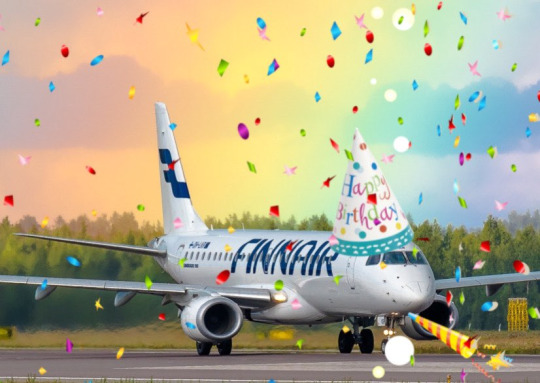
On 1 November 2023 Finnair became the sixth airline to turn 100 years old, consistent with its status as the sixth oldest airline in continuous operation. I wish I'd started this blog earlier in the year, or prioritized differently, because Aeroflot and Czech Airlines also turned 100 in 2023, but...well, I didn't. You'll probably see them both in 2024 instead. Finnair, however, was requested by @kuivamustekala - particularly their centenary liveries. Requested a long time ago, even. So I'm going to hope that late is better than never and throw Finnair one last birthday party to wrap up 2023 by looking at where they started, where they are now, and what they've been doing to celebrate.
1923: PROTO-FINNAIR
Finnair, obviously the flag carrier of Finland, was founded in 1923, but its first service was in early 2024, using a Junkers J.13 (fitted with obligatory floats, as there were no suitable airstrips in Finland at the time).
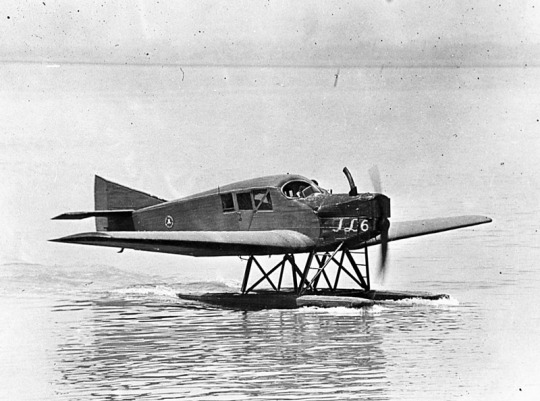
image: Joseph Eaton via US Navy National Museum of Naval Aviation This is actually the US license-built version, the Junkers-Larsen JL-6, but I couldn't find any pictures of actual J.13s on floats.
Unfortunately, Finnair was founded under the name 'Aero', which is probably the actual single worst name for an airline I have ever heard. We can jest and joke about things like Jet2 and Fly Air, but I sincerely do not think I have ever seen anything with worse SEO than an airline named 'Aero'. Even for 1923 this was fairly dire - back then, as for much of history, airlines were generally named for the area they served. Aero may have been a private company, rather than state-owned, but that didn't mean they couldn't name themselves for the area they served - private airlines have always done this and still do. Incredibly enough, there was a second 'Aero' founded in Poland in 1925, but that was quickly merged into what would become LOT Polish Airlines, shedding the name like a chrysalis.
Bafflingly, even when the Finnish government bought the airline in 1946 (they still own a majority share of it today) they didn't bother to change the name. They did begin writing 'Finnish Airlines[1]' on the fuselages, but as far as I can tell this appears to have been more of a stylistic flourish of sorts than an actual rebrand, or maybe even a clarifying subtitle on the very nonspecific name. In 1953 they began marketing under the much catchier 'Finnair', but the company remained legally named 'Aero' until literally 1968 and the fuselages still read 'Finnish Airlines'.
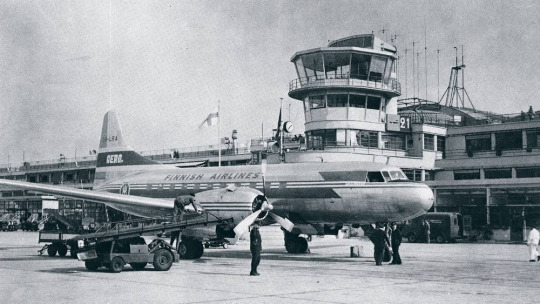
image: Finnair An Aero/Finnish Airlines Convair 340, photographed in 1953 in a livery which included both the large 'Finnish Airlines' wordmark and 'Aero' on the tail.
Early Finnair, like most early airlines, didn't have a particularly standardized livery for its fleet, and even where it did it's not very well documented. Finnair unfortunately has some of the poorest documentation for livery evolution of any large airline I've discussed so far, which really surprised me. That said, it's when the name became Finnair that things begin to be easier to find, and so that's where I'll begin.
1968: CLASSIC FINNAIR

This original logo[2], introduced in 1968, was designed by Kyösti Varis - at least, that's what every logo database I looked in said. I actually couldn't find either Finnair or Varis confirming this[3], but I still think it's probably true. Unlike designers like Vic Warren and Lindon Leader, who wrote and gave interviews about their designs for major airlines, Varis appears to have other preoccupations. He is enormously successful and prolific, to the point where his website doesn't even mention Finnair. According to the timeline he provides he would have either been creating this logo freelance or in his very last days at Advertising Agency SEK (probably the latter, since they did the two subsequent iterations), and based on his history as a typographer I think it's safe to say the letterforms are his creation as well. Also according to his timeline, he is younger than Finnair! And we almost have the same birthday.
I like the original Finnair branding. It's not ostentatious, but it's nice and sleek, with that forward slant I love in airline branding and a long unbroken line (both in the 'F' logo and in the even heights of the letters in the wordmark). It looks aerodynamic and the rounded, blocky letters have a hint of that 60s futurism while not being gimmicky. It's kind of incredible looking at it next to the '91-'94 FedEx wordmark, which occupies the opposite end of the sliding quality scale of TRON-looking text. The design as a whole is simple enough to easily reproduce but distinct enough to easily recognize. The shade of blue chosen is a fair bit lighter than the blue of the Finnish flag, but visually pleasing enough. They basically keep iterating on this general concept for the rest of their history, which I think is fantastic - no need to get rid of something that's working for you. It's nice to see an airline not feel pressured to reinvent its logo and livery every 20 years. That's about it for the logo[4] - what about the livery?
As mentioned prior, Finnair's liveries, before quite recently, were very poorly documented. Variants definitely existed between different types and different periods in the company's history, but the broad strokes of the branding seem to have remained almost startlingly intact for around thirty years.

image: Letterform Archive The cover of a style guide from 1985. If it's changed from the 1968 original, I can't tell how.
But I'm really here to talk about one thing: the liveries.
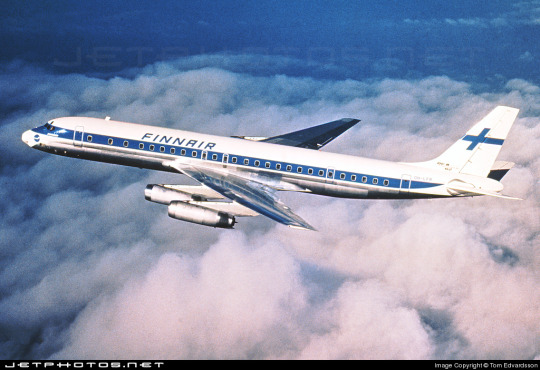
The above image was from Finnair's own archive and was taken in 1968[5], making it contemporary with the introduction of the Kyösti Varis branding, as well as lining it up with the 1969 addition of DC-8s, like the pictured airframe.
For the majority of Finnair's history, their livery is always going to look something a little bit like this. Primarily white, with a thick blue cheatline (in what I call the domino-mask style, where it's vertically centered around the cockpit windows) that lightly flips up at the very end and a blue cross on the tail to represent the Finnish flag.
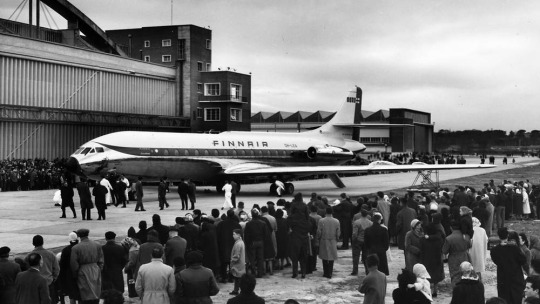
Finnair says this image is from 1960. If so, the livery was already well on its way to existing prior to 1968, with my guess being that it was introduced in 1960, along with the first jets in Finnair's fleet - the pictured Sud Aviation Caravelle, which pioneered the swept-wing, aft-engine format later seen on immensely popular jets like the DC-9 and Tu-134 - the latter of which was commissioned specifically because Nikita Khrushchev was so impressed with the Caravelle's aft engines and the quiet cabin experience they provided. It's a plane with a lot of unique visual features, featuring a nose that looks almost slanted downwards (a copy of the de Havilland Comet nose), a cruciform tail (instead of the more efficient T-tail used for future rear-engined designs), and triangular passenger windows. Most crucially, though, it was more or less the first short-range jet on the market. This made it perfect for an airline like Finnair, which at this point didn't really go that far from actual Finland.
This 1960 photograph provides a very strong blueprint for what was to come. It's the first iteration of the livery to say 'Finnair' instead of 'Finnish Airlines', and it's introduced a modern-for-1960 single-rule cheatline, although this early version was flipped horizontally, curling up at the front to frame the cockpit windows instead. (I think the white paint also cuts off behind it, leaving the space in-between the cheatline and painted nose blank metal, but in black-and-white it's somewhat hard to tell.) I do think I prefer the modern version. The use of the white downward curve with no blue hemming it in creates a really nice effect where it blends with the unpainted metal underside, due to the metal being right where you would expect to see a shadow anyway. (This effect is why I'm not quite sure where the paint ends on the Caravelle, and am just guessing based on which parts are noticeably reflective.) I definitely prefer the change made to the tail, where the single line of trim at the end of the rudder was replaced with a white canvas for the Finnish flag.
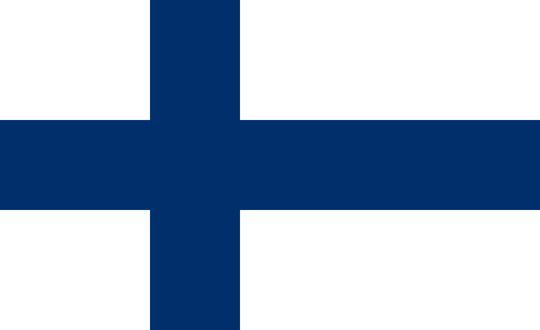
While I do tend to have a slightly pessimistic outlook on primarily-white liveries, I will say that if you're going to have a primarily white plane, and you are the flag carrier of Finland, this is a fairly understated and stylish way of incorporating it. While I probably would have done it on the main body, over where the first set of doors is, instead of on the tail, I think this is far from the end of the world. What they have is a nice, elegant taper where the tip seems to point directly at the tailplane, and it looks neat and intentional. A lot of airlines tend to just awkwardly slap a logo on their tail, which often looks really sloppy due to poor alignment or even just out-of-place entirely, and Finnair avoids that while keeping the tail from being completely blank. Having an element on the tail that's more horizontal than vertical, like the old 'AERO' rectangle or the tail rectangle on the one decent livery Lufthansa ever had.

If you look in the background, you can see that wow has the Olympic Air livery looked like that for a long time! But that's a story for soon.
Additionally, some details were added on the nose. You can see on this DC-8, photographed in 1969, that the nose features an e-girl cheek stamp of the Kyösti Varis logo. Next to it is the name of the aircraft - in this case, Jean Sibelius - in really difficult-to-read thin text. (Finnair unfortunately appears to have stopped naming their planes by the late 1970s, but at one point they would frequently be named for Finnish people and places.) The 'domino mask' goes quite a bit beyond the cockpit windows to create a wider line from the side. I wish that the logo could have been integrated some other way, because the extra little blue thing just looks cluttered, but I can't imagine how they would do it without just replacing the cheatline. I mean, that would have been an option - indeed, it's what I would have done[6] - but assuming that they keep this general look I think the logo just can't fit in on the livery. The engine nacelles, maybe? Though that would still present issues on the Caravelle, where the engines are directly over the cheatlines. I also wish they would have made it a bit easier read the name, because I like to know what the plane's name is - thankfully, some later paint jobs actually do this before, tragically, Finnair stops writing names on their planes at all.
I believe this to be the strongest iteration of the classic Finnair livery, and it was pretty obviously optimized for the DC-8. Modern airlines tend to not bother adjusting their liveries between types, creating some absolute travesties of proportion, but Finnair boldly went in the opposite direction by modifying it for each airframe and yet still having it look worse.
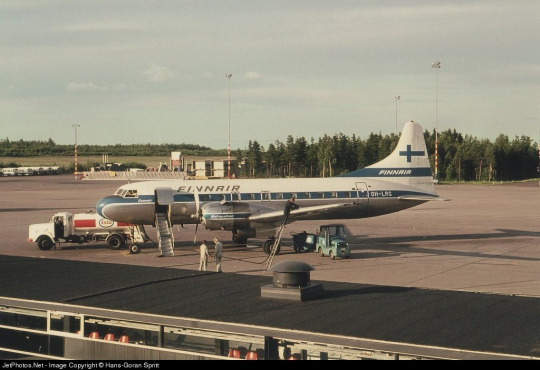
The sharpest deviation arises in the CV-440 version of the livery. This image is from 1971, just two years after the DC-8 liveries would have carried their first passengers, and it's wildly different. The cheatline is lowered sharply, sitting below the cockpit windows and wrapping around to contour the body of the airplane. There's a certain je ne sais quois to the domino mask that I find myself missing here. This design also has an unnecessary second 'Finnair' added to the tail, which kind of looks awkward stacked on top of the existing cheatline besides being redundant, and the Finnish flag on the tail is somewhat awkwardly made free-floating. It feels a lot less sleek and a lot more arbitrary.
On the other side of the plane the cheatline goes down quite a bit farther than on the jet models, probably because they thought it would be a better way of negotiating the Convair's rather bulbous nose, and I actually think I prefer the wide, upturned variant. This version, if anything, is too close for my taste to the livery VARIG operated in a similar timeframe. There are a lot of differences, yes, but in the 70s having one big solid cheatline on a white body and metal underbelly was the equivalent of the Lufthansa Line, so if you toed said line, be it cheat or Lufthansa, you risked becoming easily mistakeable for any airline with too similar of a color scheme. And blue-on-white was maybe the most common color-scheme at the time.
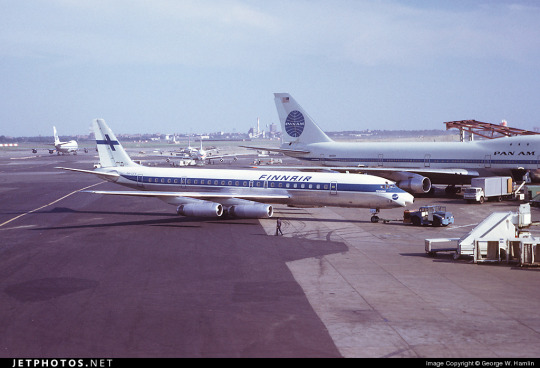
I doubt Finnair shared many tarmacs with VARIG, but here they are with Pan Am, and they could also expect to run into airlines like Sabena, Icelandair, and probably a half-dozen I've never heard of, all competing to be the one the others get mistaken for. It's a tricky position to be in.
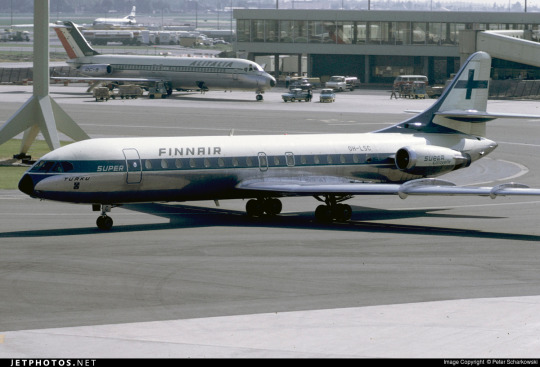
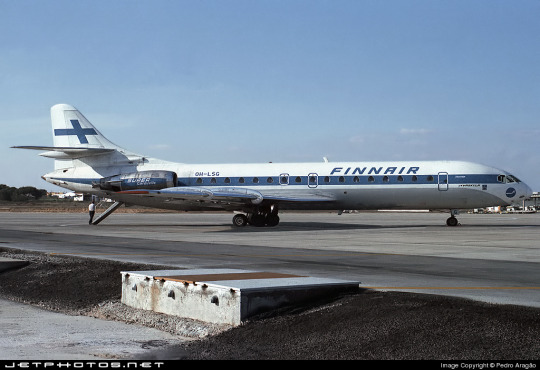
I do quite like the livery on the left, maybe even more than the DC-8 one, but I can't seem to find any other airframes painted like this. I'm not sure why this one is.
These images are from 1971 and 1969. They are both the same model of airplane - the Super Caravelle or Caravelle 10B. Their liveries are completely different. And that's just how it was back then - not even standard within the same airline, somehow still trying to stay distinct from dozens of other non-standardized blue-on-white cheatlines.
When evaluating classic Finnair, I have to keep myself tempered in both directions. When I think it's clean and well-proportioned I have to remind myself that it's just a complete nothingburger. When I think it's a lazy and cowardly non-design I have to remind myself that, no, at its best classic Finnair does look like it was designed with some thought, and it does have some traits that feel at the very least interesting enough to merit not being totally dismissed.
But...look, I have to give classic Finnair a D+. Because they tried, and they did something, sure, but it's ultimately not something especially memorable and the implementation is just spotty.
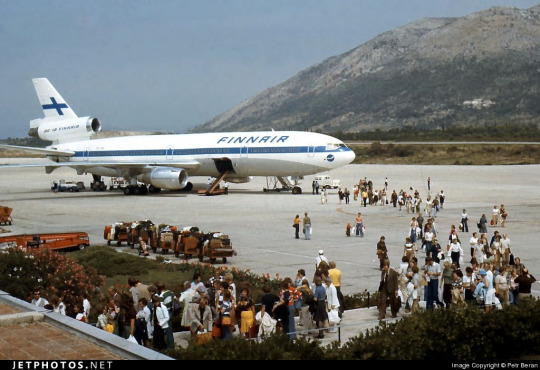
Even given a canvas like the DC-10, they fumbled. The DC-10, in my opinion, was a big test for them. And I do mean big. In the DC-10 is a plane with all the space in the world to add visual elements, and a space where just a couple lines can go from a detail to a fin that towers over anything that isn't a 747, showing off the Finnish flag as if someone had flown it from a building mast. The third engine, which I feel like a lot of airlines really struggle with on the DC-10, gets a nice horizontal line of writing that's not intrusive but helps prevent it from feeling like a giant gap. The wordmark gets larger, is moved forward, gets to really own the space it takes up instead of being squeezed in. And...they made the cheatline just....a really thin flat line that looks bad and stiff and boring. There's nothing setting them apart from Icelandair, and Icelandair's livery from this point in time was so boring that my only comment on it was that it looked like they forgot to paint the rest of the plane. You can do white planes well, but Finnair just really doesn't get there.
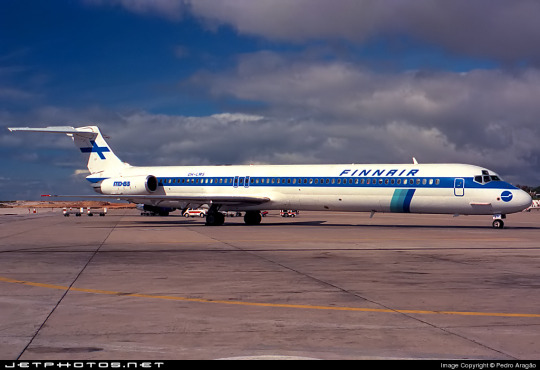
...hey, Finnair? You can't just decide to do belly stripes but worse, Finnair, you're literally next door to like two thirds of SAS and that livery was designed from the ground up. They have a couple of near-misses with SAS's toes but this is the one that makes me actually go 'is this allowed?'. It seems to have been exclusive to their late-80s MD-80 fleet, but it's just incredible to me that it ever happened. (That said, those three shades of blue are so nice together and I wish they had ever brought them back. I understand the appeal of sticking to the stark contrasted blue-on-white of the flag, but there's so much potential out there!)
1997: NEW TYPE, NEW LIVERY
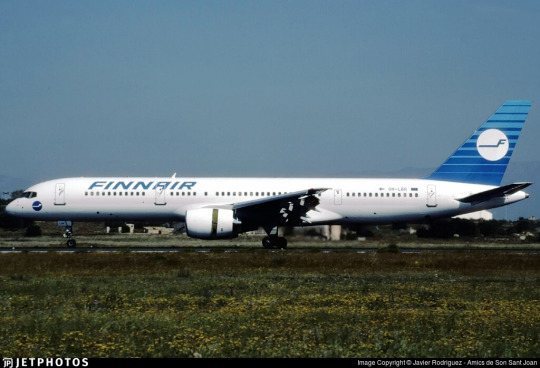
I really like the 757. It deserves a better livery than this.
Removing the cheatlines was a very trendy choice to make. This is the sad beast I call the Deltalite - a Deltalike but without the painted nacelles and belly that are usually slight redeeming factors. There's such a beautiful design on the tail that could have been put on the whole fuselage, honestly, and that's sad, but even on the most granular of levels...why keep the little cheek stamp if you have the logo visible on the tail now? Weird choice. Being so desperate to do the Deltalite thing everyone else is doing that you get rid of your country's flag on the tail is just a bad choice of priority, I think. There's not much to say about this. Honestly, I'd drop it to a D-. There's enough happening that it would lose something by being painted into Star Alliance colors, but it wouldn't lose terribly much.
2000: NEW FINNAIR

Oh, Finnair. Why? Did no airline resist the siren song of getting way too into airbrushing in the early 2000s?
Maybe I just have whatever the opposite of nostalgia is for the early 2000s, but this just makes me sad. They've made the wordmark look worse, overcomplicated the simplicity of the logo, and gone ham with the gaussian blur.
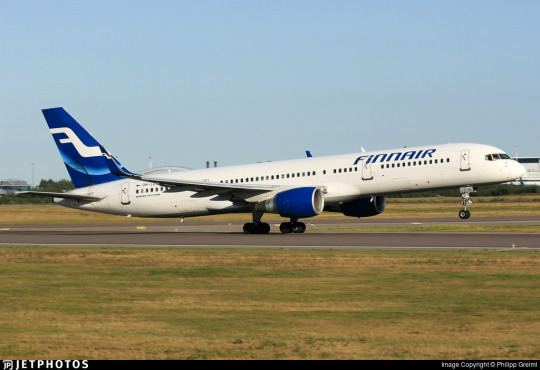
Look, it's not all that bad. The shades used on the actual plane are noticeably darker, and the colors at least don't look half bad now. And they've even bothered to paint the engines this time around! But...come on. You've changed 30 years of something that was working just fine for...this? Something which maybe climbs up to a flat D?
The 2000 brand overhaul, including the logo, was done by Finnish agency SEK & Grey. They're nearly as old as Finnair and have worked for brands as prominent as Coca-Cola and Kellogg's, but their about page puts Finnair front and center. They have an entire page describing their Finnair work.
Despite claiming to have included humanity and warmth and movement, I see none of this. I'll admit upfront I generally dislike what's dubbed 'Nordic' design. It's not the minimalism which I dislike but the banality.
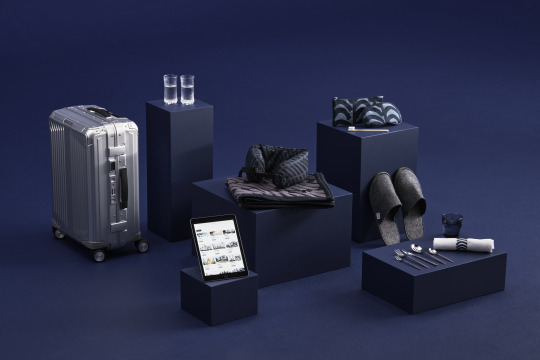
What does any of this have to do with Finnair? What here represents the history of one of the world's oldest airlines? What here really speaks to the Finnish people? Why is just designing something generic and making sure it's all crisp (when you're photographing it fresh out of the plastic, before it's been tripped over and stepped on and yanked down staircases and accidentally sat on and stained with tea) considered a substitute for designing something that people will see years down the line and get nostalgic for? I'm nostalgic as hell for Alitalia, an airline that doesn't exist anymore. I still use the bag from an amenity kit I got on Alitalia nearly ten years ago to store small essential things like toothbrushes and medication while traveling, but I wouldn't know it was Alitalia by looking at it, because it's lovely and convenient and ergonomic but it's literally just grey. It evokes nothing, and it doesn't even say 'Alitalia' on it anywhere. Nothing here could ever be considered ephemera or memorabilia. I could steal Finnair's look at the Gap.
2010: SORRY, HERE'S NEW FINNAIR FOR REAL THIS TIME

SEK & Grey gave it another shot. This one's a lot better.
I like the change in the logo, first off. And this, the word 'Finnair', is the logo, but I'm comparing it to the earlier wordmark. 2000's attempt felt like it was taking the original and just trying to sand off the corners to make it more modern, but the 2010 take on it actually shapes each glyph into a neat little space-age thing that creates this curved shape by way of a lot of straight lines, in a way that feels visually pleasing and interesting. I enjoy the square holes in the A and R, the return of the crossbar on the N, and the extreme range of widths which gives the letters a real weight to them. This isn't a typeface - these glyphs exist in the context of the word FINNAIR in this exact configuration and one of four colorways. Finnair does have a proprietary typeface, Finnair Sans, and it looks nothing like this because this is not a font, it's a logo.
I think it is a shame that this is the logo now. I really liked the F. And they haven't gotten rid of it, but it's now been relegated to an official subordinate position, according to their branding guide:
The official Finnair logo is the text version of the logo, and it is primarily used. The F emblem is used as an additional symbol.
Look, I'll always think it's a shame when your main logo is just the name of your company. Some airlines do it, and it feels like an empty space to me. It can be satisfactory but not outstanding. When you start out with a nice little symbol and then take it away, though, I do feel somewhat robbed.

It stings extra because I really like the way the new F looks. It has that long brushstrokey look and it almost makes me think of Hebrew characters. The way it tapers now really adds to the feeling of movement I get from it, and it's a great base for a livery. Now that it's darker, even though this does bring Finnair into competition with airlines like SAS, LOT, TAROM, Lufthansa, and even Ryanair when it comes to dark-blue-on-white, it also contrasts better with the main body, and it's still light enough that you can recognize it as blue. Anyway, it doesn't take a genius to know how to integrate this into a livery. Long line for the fuselage, go up to match the tail...

Finnair. Are you serious, Finnair?
Look! I get it! Billboards are in now, it's fine, I get it. it's probably the nicest billboard I've seen in a while, font-wise. It feels comfortable on the fuselage and it feels like it earns the space it occupies. The F is nicely centered on the tail, cuts off at a pleasant point. But...why?
I really can't be too mean about this. I want to be meaner than I actually can justify, because I think if any other airline made their plane this featureless I would hate it but Finnair's billboard livery is actually nice enough and everything is placed well enough that it's not at all unpleasant to look at. It's an acceptable livery. If maybe 25% less planes were basically all white it would shoot up in my esteem. I don't really like the fact that they put the little Fs on the inside of the wingtips of their A350s, but that's really my only nitpick. It's just sort of...bringing a really fantastic loaf of bread to a potluck when you were asked to bring baked desserts. You've done a very good job, but you didn't quite get the assignment.
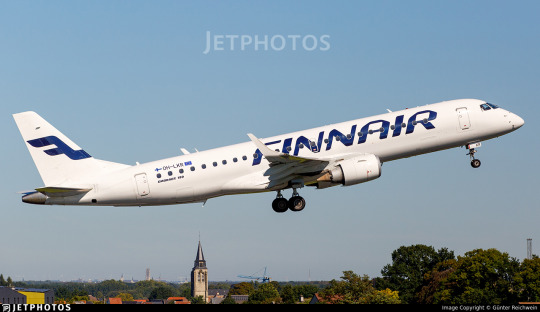
It's a bit hard to critique the modern Finnair livery in detail because I think it's executed fine. There's nothing really wrong with it except that it has a logo that could lend itself to all sorts of interesting shapes, it has 30 years of variants of a very specific design to draw on, and it's chosen to go tabula rasa just to be all clean and minimal instead of doing any of the interesting things it could have with this new start.
I want to dislike this take on the Finnair livery, but at the end of the day I just don't. I think it's completely satisfactory. A lot of airlines try to get this look and somehow end up seeming cluttered for it. Finnair is one of the only instances I can think of where a white fuselage with just a wordmark has looked okay. It isn't ugly. It hasn't failed at the thing it's trying to do, but I think that it should have tried to do something else.
At the same time, though, this is the most Finnair that Finnair has ever been. The blue cheatline and the Deltalites were stumbling over well-trod ground. The modern livery, at least, isn't sloppily tail-heavy and seemingly thoughtless.
I give modern Finnair a C. This took an excessive amount of deliberation, but it really is...good enough. It's satisfactory. It's fine! I would have taken a completely different direction, but they have done a good job with their sort of lackluster idea. It's alright. We'll check on them again in another hundred years and see where they're at.
2023: CENTENAIRY
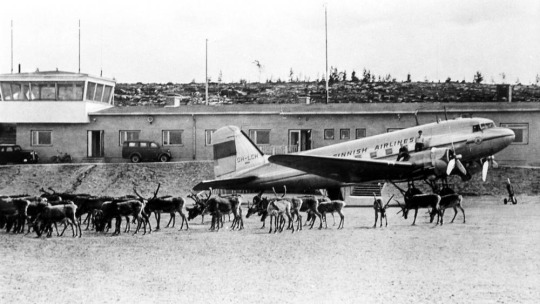
A century is a very long time. Finnair is older than my oldest grandparent. Finnair is older than over a dozen sovereign countries. Finnair is older than aerodromes in Finland. It's older than every currently operating airline except KLM, Avianca, Qantas, Aeroflot, and Czech Airlines. As of the first of November, Finnair is in triple digits.
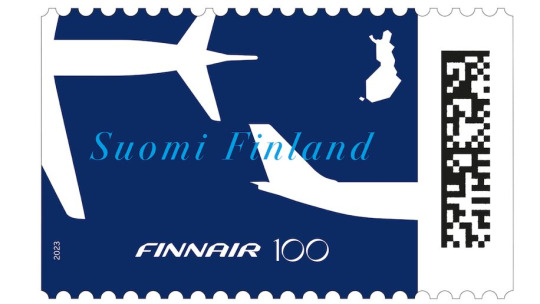
I adore this centenary stamp Finnair has put out, celebrating the long relationship between aviation and the mail. It's not complex, but it's not barren, either. It combines the dark blue of the modern livery with the light blue of the classic one, all with the white silhouettes of airplanes elegantly soaring over an outline of Finland. The outstretched white wings on the deep blue have the grace of a giant fish swimming beneath a glass-bottomed boat.
But of course it isn't just stamps. Finnair is an airline. Airlines do special liveries. Qantas and KLM both slapped a big 100 sticker on an airplane for their big anniversaries. Finnair has of course done something similar.
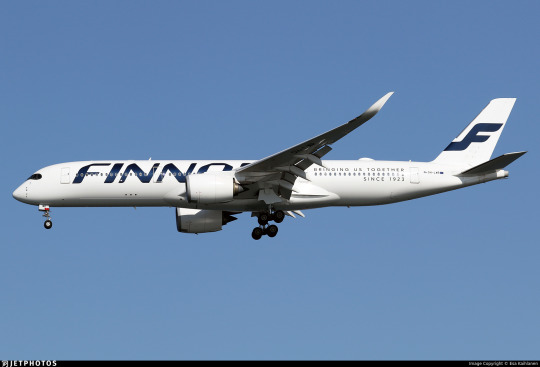
Three airframes - the pictured A350-900, OH-LWR, and two A320s - OH-LXK and OH-LXM - have had a 'bringing us together since 1923' sticker applied. Matching the rest of Finnair's branding, it's certainly quite minimal, but it's a nice gesture. It's not what people have been talking about. That's OH-LWO and OH-LWP, both A350-900s, who have been given something more substantial to wear.
youtube
I'm going to assume that after its renaissance on tumblr a few years back most people reading this are familiar with the Moomin franchise. I definitely am, because when I was in my larval stage my mother first taught me to read Russian using an omnibus book of Moomin stories. Creator Tove Jansson apparently designed both the shape of the eponymous white critters and the sound of the name Mumintrollen itself are designed to evoke a feeling of softness, and it's clear why these characters are so beloved.
It isn't the first time Finnair, which frequently collaborates with Finnish brands and highlights its Finnish roots, has featured Moomins.
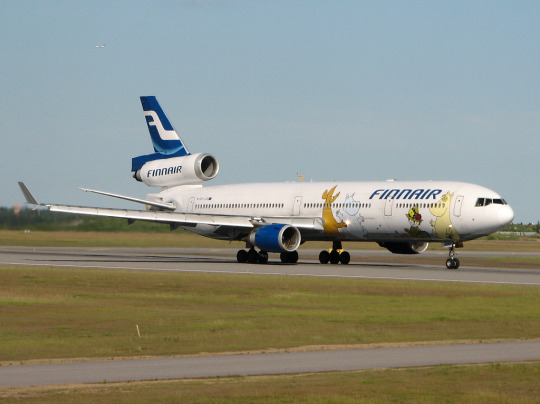
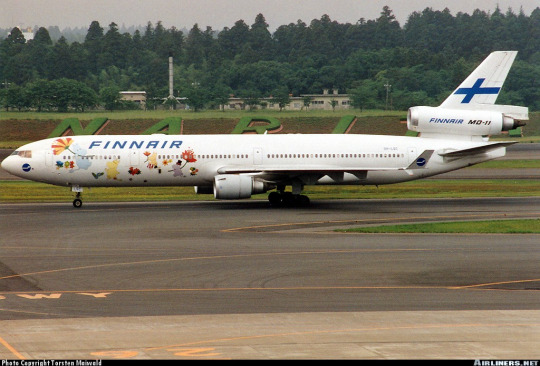
image on left: Antti Havukainen
In the 1990s, the airline first flew a Moomin jet. They had another in the 2000s. Both were withdrawn from service before 2010. It's been a while now since Finnair flew their last MD-11, but when celebrating their 100th birthday, a milestone that the vast majority of airlines will never see, they chose to do it by way of a soft Moomin embrace.
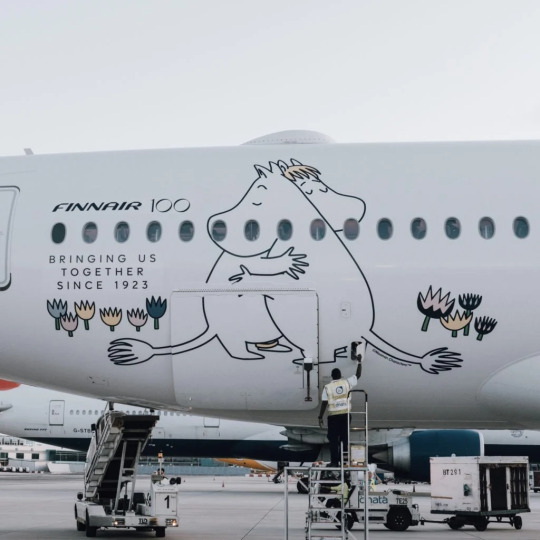
image: Changi Airport
And, I'll be honest, I think it's very sweet. It got an actual, sincere little smile out of me.
100 years is a really long time. In 1923 aviation was unrecognizable. What we would now consider an airliner didn't really exist yet - space for ten passengers, closed cockpits, and metal fuselages were the exceptions rather than the rule, and the Ford Trimotor was two years from its first flight. Cabin crew were barely even a concept. Airplanes, for all intents and purposes, were considered a type of boat. A nonstop flight across the Atlantic was a ridiculous concept. In a report published by the US National Bureau of Standards, it was said: 'there does not appear to be, at present, any prospect whatever that jet propulsion of the sort here considered will ever be of practical value, even for military purposes'. There were no aerodromes in Finland, so a small company called Aero attached floats to a plane just large enough for four passengers and took them from Helsinki to Tallinn.
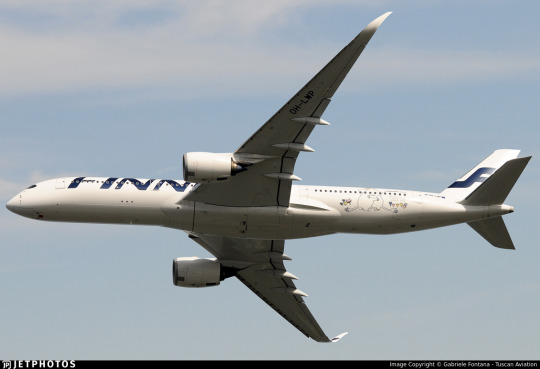
Look how far we've come.
Footnotes:
[1]: The Finnair website's history page, which I used as a source for much of the background and several images in this post, renders it as 'Finnish Air Lines', but on the airplanes themselves it clearly has no space, so I've corrected that seeming error for them. I don't know why this discrepancy exists, because as far as I know during this period they were marketing themselves as Aero so this text would only have existed on the livery itself. [2]: Actually, I very occasionally see this version where the F logo isn't fully surrounded by the circle and the F in the wordmark doesn't have the rounded top, and I don't know which came first or if the less round version is just somehow...not real? I did try to figure this out, I swear, but at some point I realized I am literally not a professional logo historian, and nobody is going to be let down if I don't brute-force an answer despite not even speaking Finnish, and I should finish writing the post before it's 2024. [3] The closest thing to an official source I can find is the descriptions of two listings for the centenary stamp including a quote from designer Ilkka Kärkkäinen attributing it to him. I don't at all doubt that he did design it, but I always like to find concrete attribution for things if I can and would hate to spread misinformation and the sparseness of confirmation here is something I find very strange. My best guess is that there's plenty of good sources on it in Finnish but nobody has bothered to make it as clear in English. [4] Admittedly this is a stretch, and I certainly don't think it was intentional, but it does remind me of the longship prow used in early SAS liveries. This motif was introduced in 1946 and continued to see use after the Finnair logo was introduced. The overlap is fairly limited in that SAS never used the longship in their logo (...I kind of want to talk about their logos one of these days) and the Finnair livery you'll see shortly doesn't look like SAS's at all, plus SAS has the extra pink on their liveries, but I couldn't get it out of my head that they do look sort of alike. [5] The absolute hero who uploaded it to jetphotos mentioned that Finnair had given him the photograph while planning to dispose of it, and this makes me wonder if the lack of documentation is just because Finnair doesn't hold onto their old materials, which makes me very sad. A lot of companies, more broadly, didn't bother to keep records until somewhat recently, but in Finnair's case it seems to be particularly egregious. As someone literally studying to be an archivist it makes me exceptionally sad to see history lost just because nobody cared enough to preserve it. [6] Maybe they didn't want to look like backwards SAS. Who can say?
#tarmac fashion week#finnair#grade: c#grade: d+#region: finland#grade: d#grade: d-#region: northern europe#era: 1960s#era: 1970s#era: 1980s#era: 1990s#era: 2000s#era: 2010s#era: 2020s#special liveries#commemorative liveries#requests
50 notes
·
View notes
Text

airsLLide No. 18777: G-OKDN, Boeing 737-8Q8, Sabre Airways, Corfu, June 18, 2000.
Sabre Airways was founded in December 1994 to operate leisure flights for the British market, mostly to destinations in the Mediterranean. In addition, it also offered ACMI services with its fleet of initially Boeing 727s, later Boeing 737-800s.
In 2001, following the acquisition of over 66% of its shares by Libra Holdings, the airline altered its name to Excel Airways and added Boeing 767 widebodies to the fleet. In 2004, the Avion Group that also owned Air Atlanta Icelandic acquired a 40% share of Excel Airways.
Following a management buy-out in 2006, XL Leisure Group became the new owner of the airline, and its name was changed once more to XL Airways. Ssister airlines in France (Star Airlines) and Germany (Star Europe) were re-branded accordingly to XL Airways France and XL Airways Germany at the same time.
XL Leisure Group had to file for bankruptcy on September 11, 2008, citing week demand and an economic slow-down. That move also sent XL Airways UK, née Sabre Airways, into liquidation, while the French and German subsidiaries initially escaped bankruptcy and stayed afloat until 2012 (XL Germany) and 2019 respectively (XL France).
3 notes
·
View notes
Text
Why Millennials aren’t leaving Tiktok

I'm on tour with my new, nationally bestselling novel The Bezzle! Catch me TOMORROW NIGHT (Mar 22) in TORONTO, then SUNDAY (Mar 24) with LAURA POITRAS in NYC, then Anaheim, and more!

The news that Gen Z users have abandoned Tiktok in such numbers that the median Tiktoker is a Millennial (or someone even older) prompted commentators to dunk on Tiktok as uncool by dint of having lost its youthful sheen:
https://www.garbageday.email/p/tiktok-millennials-turns
But "why are Gen Z kids leaving Tiktok?" is the wrong question. The right question is, why aren't Millennials leaving Tiktok? After all, we are living through the enshittocene, the great enshittening, in which every platform gets monotonically, irreversibly worse over time, and Tiktok is no exception:
https://pluralistic.net/2023/01/21/potemkin-ai/#hey-guys
To understand why older users are stuck to Tiktok, we need to start with why younger users relentlessly seek out new platforms. To some extent, it's just down to youth's appetite for novelty, but that's only part of the story. To really understand why people come to – and leave – platforms, you have to understand switching costs.
"Switching costs" is the economists' term for everything you have to give up when you change products or services. Switching from Ios to Android probably means giving up a bunch of your apps and purchased media. Switching from an airline where you're a high-status frequent flier to another carrier means giving up on free checked bags and early boarding.
In an open market, rivals have lots of ways to lower these switching costs (it's an open secret that you can call an airline and say, "Hi, I'm a 33rd Order Mason on American Airlines, will you make me a Triple Platinum Diamond Sky-Baron if I switch to Delta?"). Of course, big incumbents hate this, and do everything they can to increase their switching costs, finding ways to impose high switching costs that punish disloyal consumers who have the temerity to go elsewhere.
With social media, lock-in comes for free, thanks to the "collective action problem." Getting people to agree on a given course of action is hard, and as you add more people to the picture, the problem gets harder. It's hard enough to get half a dozen people in your group-chat to agree on where to go for dinner or what board-game to play. But once you're reliant on a social media service to stay in touch with friends, relatives around the world, customers, communities (say, rare disease support groups), and coordination (like organizing your kid's little league car-pool), the problem becomes nearly insoluble. Maybe you can convince your overseas relatives to switch to a Signal group, but can you do the same for your small business's customers, or your old high-school pals?
https://pluralistic.net/2022/10/29/how-to-leave-dying-social-media-platforms/
Taken together, switching costs and collective action problems make platforms "sticky," and sticky platforms inevitably enshittify.
Platforms, after all, generate value. They connect end-users with each other (say, little league parents) and they connect end-users to business customers (you and your small business's customers). That value needs to be parceled out among end users, business customers, and the platform's shareholders. A platform can make life better for business customers at its end users' expense by increasing the number of ads (hello, Youtube!), and it can make life better for its shareholders at its business customers' expense by decreasing the share of ad revenue given to publishers or performers (oh, hello again, Youtube!).
From a platform's perspective, the ideal state is one in which end users and business customers get no value from the platform, because it's all being captured by the platform's shareholders. But if Youtube interrupted every 30 seconds of video for ten minutes of ads and paid the video creators nothing, both users and creators would ditch the platform – and advertisers would follow:
https://www.youtube.com/watch?v=Dab8sKg8Ko8
So platforms seek an equilibrium: "what is the least value we apportion to end-users and business customers without triggering their departure?" Maybe that means giving more value to end-users (for example, keeping Uber fares low by suppressing wages), or to business-customers (crowding more ads into your social media feed).
Every business – including brick-and-mortar, non-digitized ones – wants to find some kind of equilibrium between the value going to its suppliers, its customers and its owners, but digital businesses have an advantage here: digital systems are flexible in ways that analog, hard-goods businesses are not. Digital businesses can alter pricing, payouts and other dynamics from moment to moment – second to second – and make a different offer to every supplier and customer. They have a bunch of knobs, and they can twiddle them at will:
https://pluralistic.net/2023/02/19/twiddler/
Well, not quite at will. Businesses face constraints on their twiddling. If they get too greedy, users or business customers might weigh the cost of staying against the switching costs and decide it's not worth it. But the more expensive – the more painful – a platform can make leaving, the more pain they can inflict on the people who stay.
In other words, there's two ways to keep a customer or supplier's business: you can make a better service so they won't want to leave, or you can make leaving the service so painful that they stay even if you mistreat them.
There's three ways a digital company can make things worse for their customers and users without losing their business.
First, they can eliminate competition (think of Mark Zuckerberg buying Instagram to recapture the users who'd fled Facebook to escape his poor management):
https://pluralistic.net/2023/09/03/big-tech-cant-stop-telling-on-itself/
Second, they can capture their regulators and avoid punishment for trampling their suppliers' or users' legal rights (think of how Amazon has raised the price of everything we buy, both on- and off Amazon, through its "most favored nation" deals):
https://pluralistic.net/2023/04/25/greedflation/#commissar-bezos
Third, they can use IP law to prevent competitors from modifying their services to claw back some of that value (think of how Apple used legal threats to block an Android version of Imessage, blocking Apple customers from having private conversations that included non-Apple customers:
https://pluralistic.net/2024/01/12/youre-holding-it-wrong/#if-dishwashers-were-iphones
Companies can't just use this tricks at will, of course. Antitrust laws can block companies from making anticompetitve acquisitions or mergers. Regulators can punish companies for cheating their customers, workers and users. Technologists can come up with clever ways of modding or reconfiguring existing services with "interoperable" add-ons that let users bargain for better treatment by refusing to accept worse:
https://www.eff.org/deeplinks/2019/07/adblocking-how-about-nah
Day in, day out, the decision-makers at tech companies test these constraints, twisting the knobs that shift value away from users to shareholders. Their bosses and boards motivate them with "KPIs" that dangle the promise of huge bonuses and promotions for any manager who successfully enshittifies part of the company's products:
https://pluralistic.net/2023/07/28/microincentives-and-enshittification/
Decades of pro-corporate, pro-monopoly policy has loosened those knobs. 40 years of lax antitrust meant that companies had a lot of leeway to buy or merge with rivals – that's changing today, but it's tough sledding:
https://pluralistic.net/2023/07/14/making-good-trouble/#the-peoples-champion
As sectors grew more concentrated, they found it easier to capture their regulators, so that they no longer fear punishment for price-gouging, spying, or wage-theft, so applying the same amount of torque to the "break the law" knob cranks it a lot further:
https://pluralistic.net/2022/06/05/regulatory-capture/
Once you've captured your regulators, you can aim them at your competitors. A monopoly-friendly policy environment has transformed IP law into a bully's charter, allowing powerful companies to strangle would-be competitors who dare to offer their customers tools to shield themselves from enshittification, like scrapers, ad-blockers and alternative clients. Big companies can crank the enshittification knob all the way over and know that smaller rivals knobs won't turn at all:
https://pluralistic.net/2022/10/20/benevolent-dictators/#felony-contempt-of-business-model
At one point, bosses faced one more constraint on knob-twiddling: their workforce. Many tech workers genuinely cared about their users' welfare, something bosses encouraged as a sneaky trick to get techies to put in long hours without exercising their leverage by quitting rather than destroying their lives to meet arbitrary deadlines. These workers would fearlessly slap their bosses' hands when they reached for the enshittification knob, threatening to quit rather than allowing the products they'd given so much for to be enshittified. Today, after hundreds of thousands of tech layoffs, tech workers are far less like to challenge their bosses' right to twiddle, and far more likely to get fired if they try:
https://pluralistic.net/2023/09/10/the-proletarianization-of-tech-workers/
All this means that tech bosses don't have to change their approach at all, and yet, their services will grow steadily worse. The boss who twiddles the enshittification knob in exactly the same way as he did a year or a decade ago will find it turning much further, because his customers are locked into his platform, his regulators won't protect them, the same regulators will stop his competitors' attempts at countertwiddling, and his workers fear losing their jobs too much to speak up for their users.
That's the contagion that produced the enshittocene: the forces that constrained companies (competition, regulation, self-help and labor – all melted away, allowing every company's MBA-poisoned knob-twiddling leaders to shamelessly caress their knobs with every hour that God sends:
https://pluralistic.net/2024/01/30/go-nuts-meine-kerle/#ich-bin-ein-bratapfel
Which is why people want to leave platforms. When a platform loses its users, those users have weighed the switching costs against the pain of staying and decided that it's better to bear those costs than to stay.
So why have Tiktok's younger users found the costs too high to bear, and why have their elders remained stuck to the platform?
For that, we have to look at the unique characteristics of young people – characteristics that transcend the lazy cliche that kids are easily bored, fickle novelty-seekers who hop from one service to another with unquenchable restlessness.
Whether or not kids are novelty-seekers, they are, fundamentally, a disfavored minority. They want to do things that the platforms don't want them to do – like converse without being overheard by authority figures, including their parents and their schools (also: cops and future employers, though kids may not be thinking about them as much).
In other words, kids pay intrinsically lower switching costs than adults, because a platform will always do less for them than it will for grownups. This is a characteristic kids share with other supposedly technophilic, novelty-seeking "early adopters," from sex-workers to terrorists, from sexual minorities to trolls, from political dissidents to fascists. For those groups, the cost of mastering a new technology and assembling a community around it is always more likely to be worth bearing than it would be for people who are well-served by existing tools:
https://pluralistic.net/2022/06/21/early-adopters/#sex-tech
Pornographers didn't jump on home video because of its superiority as a medium for capturing flesh-tones. Home video was a good porn medium because it was easier to discreetly get into the hands of porn consumers, who could, in turn, discreetly view it. The audience for porn in the privacy of your living room is larger than the audience for porn that you can only watch if you're willing to be seen marching into a dirty movie theater.
Every new technology is popularized by a mix of disfavored groups and neophiles, who normalize and refine it – and yes, infuse it with their countercultural coolth – until it becomes easy enough to use to become mainstream. As more normies drift into the new system, the switching costs associated with leaving the old system declines. It gets easier and easier to find the people and services you want in the new realm, and harder and harder to find them in the old one.
This is why tech platforms have historically experienced sudden collapse: the platform that gets more valuable and harder to leave as it accumulates users gets less valuable and easier to leave as users depart:
https://www.zephoria.org/thoughts/archives/2022/12/05/what-if-failure-is-the-plan.html
If you're a Gen Z kid on Tiktok, you experience the same enshittification as your Millennial elders. But you also experience an additional cost to staying: as late-arriving adult authority figures become more fluent in the platform, they are more able to observe your use of it, and punish you for conduct that you used to get away with.
And if you're a Millennial who isn't leaving Tiktok, it's not just that you experience the same enshittification as those departing Gen Z kids – you also face higher switching costs if you go. The older you get, the more complex your social connections grow. A Gen Z kid in middle school doesn't have to worry about losing touch with their high-school buddies if they switch platforms (they haven't gone to high school yet – and they see their middle school friends in person all the time, giving them a side-channel to share information about who's leaving Tiktok and where they're headed to next). Middle-schoolers don't have to worry about coordinating little league car-pools or losing access to a rare disease support group.
In other words: younger people leave old platforms earlier because they have more to gain by leaving; and older people leave old platforms later because they have more to lose by leaving.
This is why Facebook is filled with Boomers. Yes, their kids bolted for the exits to avoid having their parents (or grandparents) wading into their sexual, social and professional lives. But the reason the Boomers were late joining younger users' Facebook exodus – or the reason they never joined it – is that they stand to lose more by going. Facebook deliberately cultivated this dynamic, for example, by creating a photo hosting service designed to entice users into uploading their family photos while disguising how hard it would be to take those photos with them if they left:
https://www.eff.org/deeplinks/2021/08/facebooks-secret-war-switching-costs
The irony here is that tech has intrinsically low switching costs. All other things being equal, a new platform can always build a bridge to ease the passage of users from the old one. There's no (technical) reason that moving to Mastodon, or Bluesky, or any other platform should mean cutting ties with the people who stayed behind.
A combination of voluntary interoperability (where old platforms offer APIs to allow new services to connect with them), mandatory interop (where governments force tech companies to offer APIs) and adversarial interop (where new companies hack together their own API with reverse-engineering, scraping, bots, and other guerrilla tactics) would hypothetically allow users to hop between networks as easily as you change phone carriers:
https://pluralistic.net/2022/12/19/better-failure/#let-my-tweeters-go
Tech platforms tend to offer APIs when they're getting started (to ease the inward passage of new users) then shut them down after they attain dominance (locking the door behind those users). The EU is tinkering with mandatory APIs through the Digital Markets Act (though bafflingly, they're starting with encrypted messaging rather than social media). Restoring adversarial interoperability will require extensive legal reform, which is getting started through Right to Repair laws:
https://www.techdirt.com/2024/03/13/oregon-passes-right-to-repair-law-apple-lobbied-to-kill/
The people who are stranded on social media platforms shouldn't be mistaken for uncool, aging technophobes. They're not stubborn, they're stranded. Like the elders who can't afford to leave a dying town after the factory shuts down and the young people move away, these people are locked in. They need help evacuating – a place to go and a path to get there.
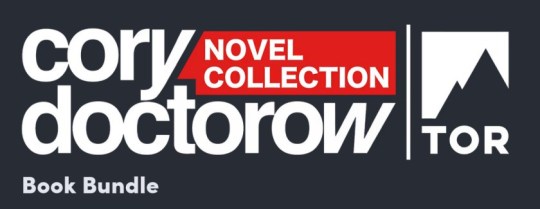
Name your price for 18 of my DRM-free ebooks and support the Electronic Frontier Foundation with the Humble Cory Doctorow Bundle.

If you'd like an essay-formatted version of this post to read or share, here's a link to it on pluralistic.net, my surveillance-free, ad-free, tracker-free blog:
https://pluralistic.net/2024/03/21/involuntary-die-hards/#evacuate-the-platformsr
432 notes
·
View notes
Video
youtube
Why Does Flying Suck so Much?
You might not believe this, but I’m old enough to remember when flying was fun.
Now I'm sure you've got your own airline horror stories, which I hope you’ll share. But what happened to make flying such a nightmare?
The answer is simple: the same things happening across most industries. In fact, a close look at airlines reveals five of the biggest problems with our economy.
Number 1: Consolidation means fewer choices.
While there were once many more airlines, a series of mergers and acquisitions over the last three decades has left only four in control of about 80% of the market.
This kind of consolidation has been happening all over the economy. For example, four companies now control 80% of all beef production, and two control over 60% of all paper products. This lack of competition has led to:
Number 2: Companies Charging More for Less
Even before recent airfare spikes, air travel was getting more expensive because of new fees for things that used to be free, like in-flight meals, checked bags, or even carry-ons.
Spirit Airlines even charges $25 to print your boarding pass at a ticket counter! It’s just a piece of paper!
One of the ugliest ad-ons is the fee some airlines charge for families to sit together. That doesn’t even cost them anything!
Airlines are leading an economy-wide trend of adding often unexpected new charges to goods and services without adding value.
And you’re getting less in return. Airlines have cut an estimated 8 inches of legroom and two inches of seat width in the last two decades. Doesn’t bother me (I’m short), but many of you may feel the squeeze.
This parallels other industries where you’re paying more for less — just look at how cereal boxes, rolls of toilet paper, and candy bars are all shrinking.
Number 3: Exploiting Workers
While their jobs have become more difficult, many flight attendants haven’t had a raise in years.
And a lot of their hardest work is totally unpaid, because most flight attendants don’t get paid during the boarding process. They’re off the clock until the plane’s doors close.
And if the flight is delayed, those are often extra hours for no extra money.
Again, this mirrors trends in the overall economy, where too many workers are pushed into unpaid overtime or made to do work or be on call during their off hours.
Number 4: The Illusion of Scarcity
Airlines pretend they have no choice but to raise prices, cut services, and limit payroll. But their profits are in the stratosphere. In the five years before the pandemic, the top 5 airlines were flush enough to pay shareholders $45 billion, largely through stock buybacks.
During the pandemic, they got a $54 billion bailout from taxpayers (you’re welcome).
In the years since, they’ve resumed flying high, with nearly $10 billion in net profit expected across the industry in 2023. They can afford to take care of workers and customers.
Whether it’s multi-millionaire movie moguls pretending they can’t afford to pay writers or a grocery chain blaming “inflation” for high prices while raking in record profits, this illusion of scarcity is a sham.
Number 5: Misdirected Rage
Instead of being mad at the people at the top, we’ve been tricked into being mad at each other. Fights have broken out over whether it’s ok to recline a seat or who gets overhead bin space. But reclining’s only an issue because airlines intentionally put the seats too close together. And bin space is only running out because they’ve made it expensive to check bags — and also risky, with the rate of lost bags doubling over the last year.
Airlines are pitting us against each other the same way billionaires and their political lackeys pit groups against each other in society, hoping we’ll blame unions or immigrants or people of other races or religions or gender identities for why it’s so hard to get ahead, and that we won’t notice how much wealth and power is in the hands of so few.
So what do we do?
A lot of these problems could be solved with tougher antitrust enforcement — which we are starting to see. The Justice Dept is suing to block JetBlue from buying Spirit Airlines. We need that kind of anti-monopoly protection across the board.
Another part of the solution is unions. Airline workers are among the wave of American workers organizing to demand better pay and working conditions.
And then there’s your power as an informed consumer. Companies get away with bad behavior when we accept their excuses that there’s just no other way to run a business. They’re counting on us not knowing what’s really going on. So share this video, and share your airline stories in the comments.
Finally, try to be a little nicer to service workers and your fellow passengers — on planes and in life. After all, we’re all on this journey together.
371 notes
·
View notes
Text
Brazil government supports Gol-Azul merger to strengthen airline sector

A planned merger between Brazilian airlines Gol (GOLL4.SA), opens new tab and Azul (AZUL.N)
, opens new tab would strengthen the sector and prevent either company from failing, Brazil's ports and airports minister told Reuters, giving the potential move a key government nod.
Azul and Abra, the majority investor of Gol and Colombia's Avianca, announced earlier this month they had signed a non-binding memorandum of understanding with the intent of combining their businesses in Brazil.
"It's a government priority to preserve the aviation sector and, above all, safeguard jobs and incomes," Silvio Costa Filho said in an interview. "The possibility of a Gol-Azul merger is positive to strengthen Brazil's aviation."
The merger of the two airlines would create a dominant carrier in Latin America's No.1 economy as the combined company would hold roughly 60% of the domestic market, surpassing the 40% market share of LATAM Airlines (LTM.SN), opens new tab.
Continue reading.
2 notes
·
View notes
Text

Batangas: My Sky and Earth—An Intimate Recollection and Reflection of My Childhood in the Philippines
To celebrate the first anniversary of Batangas: My Sky and Earth, the author is thrilled to present a special Second Edition! The eBook and hardcover editions feature high-resolution photographs in both monochrome and color, while the paperback offers enhanced black-and-white images from the original release. This unique Second Edition is a heartfelt gesture of gratitude from the author to thank readers and commemorate this significant milestone.
About the Book
When Bong Serrano learned that his older brother, Boying, had cancer, the notes he had jotted down about his childhood took on new meaning. Memories of his time with his family in the Philippines came rushing back. At the center of those memories were the precious moments he'd spent with his Kuya. Faced with his brother's impending death, Bong asked himself: "What if one day I lose my memories? Who will remember us?" Thus began Bong's yearslong journey of immortalizing not only his childhood but also his country's history and traditions. Bong grew up in the southern province of Batangas, on Luzon Island. Batangas: My Sky and Earth is a celebration of that childhood. This memoir takes you into a world made rich by the intricate descriptions of life in the Philippines in the 1970s and '80s, where the family unit is close, and many households are multigenerational. From family dynamics to church duties to delicious food and the inevitable annual typhoons, Bong invites you to experience his culture from the inside. Throughout this memoir, Bong honors his childhood home and country and the memory of his beloved brother. The choice to interweave Tagalog throughout this book's pages helps to steep the story in Filipino culture further. A whole village raised this boy, and as Bong looks back on his childhood, the lessons he learned come to the foreground: clarity, forgiveness, tradition, and love.
About the Author
Bong Serrano is a proud Batangueño, hailing from the picturesque and historic province of Batangas, Philippines. His debut memoir, Batangas: My Sky and Earth, not only pays homage to his roots but also takes readers on a nostalgic journey into the heart of Filipino heritage.
Bong completed his undergraduate studies with an academic scholarship at Ateneo de Manila University and was subsequently awarded a student exchange scholarship at International Christian University in Tokyo. After dedicating several years as an international flight attendant and Japanese speaker for American Airlines, immersing himself in diverse cultures around the world, he transitioned to roles as Digital Marketing Director at both a digital marketing agency and a not-for-profit organization for men’s health in Vancouver, contributing his expertise to both organizations over a twenty-seven-year career in digital marketing.
Though Bong has called Canada home for many years, his heart remains deeply connected to Batangas, where he frequently returns to visit family and friends. He cherishes the bonds he holds dear and finds joy in sharing stories, listening to music, taking long walks along the seawall, mastering the art of cooking adobo, indulging in Asian dramas during his leisure hours, and, naturally, pursuing his passion for writing and storytelling. Bong resides in Vancouver with his life partner of over thirty years.
Bong is currently immersed in his next project, which involves writing a historical fiction. Connect with him and explore more of his work on his website at bongserrano.com.
Watch the Video Trailer
The full-length video montage of my debut memoir, premiering on YouTube for the first book signing event at Indigo on Robson Street, Vancouver, on March 3, 2024.
youtube
Second Edition Now Available in Hardcover, Paperback, and eBook
Bong Serrano Media
Amazon.ca
Amazon.com
Barnes & Noble
#batangas#memoir#non fiction#new book#autobiography#reading#childhood#childhood memories#childhood nostalgia#nostalgic#70s kids#nostalgia#80s#filipino#philippines#hardcover#paperback#ebook#kindle#kindle unlimited#ingramspark#indie#tagalog#batangueño
2 notes
·
View notes
Text
Section 1: Planning Your Budget Vacation
1.1 Setting a Budget
Establish a clear budget for your trip, factoring in transportation, lodging, meals, and activities. Use budgeting tools or apps to keep track of expenses and prioritize your spending.
1.2 Researching Destinations
Some destinations offer more value than others. Research places known for their affordability, such as Southeast Asia or Eastern Europe, and consider traveling during the off-peak season to save on costs.
1.3 Travel Tips
Utilize travel apps and websites to compare prices. Set alerts for flight deals and be flexible with your travel dates to take advantage of the best rates.
Section 2: Finding Affordable Accommodation
2.1 Types of Budget Accommodation
Explore a variety of budget options including hostels, motels, and guesthouses. Look into vacation rentals that can offer more space and amenities for families or groups.
2.2 Best Platforms for Booking
Platforms like Booking.com, Hostelworld, and Airbnb provide a range of options. Learn to navigate these sites effectively by using filters and sorting features to find the best deals.
2.3 Unique Stays on a Budget
Consider unique lodging options such as glamping sites, houseboats, or tiny homes. These can provide memorable experiences without a hefty price tag.
Section 3: Affordable Vacation Packages
3.1 Understanding Vacation Packages
Vacation packages often combine flights, hotels, and sometimes activities at a lower cost. Understand how these packages work to maximize your savings.
3.2 Where to Find Deals
Research travel agencies that specialize in budget trips, and don’t forget to check out last-minute deals on various travel websites.
3.3 Tips for Creating Your Own Package
Learn how to bundle flights and accommodations effectively. Use examples to demonstrate how to save by planning your own itineraries.
Section 4: Activities and Attractions on a Budget
4.1 Free and Low-Cost Activities
Highlight free activities available at your destination, such as hiking, city walking tours, and local markets.
4.2 Discounts and Passes
Promote the idea of city passes that offer discounts on attractions and public transport. Share tips on how to take advantage of student and senior discounts.
4.3 Making the Most of Your Destination
Encourage travelers to explore local cuisine through affordable street food options. Highlight the importance of connecting with locals for insider tips on budget-friendly activities.
Section 5: Travel Hacks for Saving Money
5.1 Transportation Tips
Provide tips for finding cheap flights, such as using budget airlines or flying during off-peak hours. Explain how to navigate public transportation in new cities.
5.2 Packing Smart
Offer advice on packing light to avoid baggage fees and the importance of bringing essential items like reusable water bottles and snacks.
5.3 Money-Saving Apps
List apps that help travelers save money, such as Skyscanner for flights, HotelTonight for last-minute hotel deals, and GasBuddy for road trips.
Section 6: Real-Life Success Stories
6.1 Case Studies of Affordable Trips
Share inspiring stories from travelers who managed to explore new destinations on a budget. Include their favorite tips and tricks.
go for more @towardsway.in
2 notes
·
View notes